
Surfing communities and their potential for
grassroots environmentalism
A comparison of Ukraine and Germany
Oksana Dmytriak
Isabelle van der Graaf
Pia Luisa Reker
Main field of study – Leadership and Organisation
Degree of Master of Arts (60 credits) with a Major in Leadership and
Organisation
Master Thesis with a focus on Leadership and Organisation for Sustainability
(OL646E), 15 credits
Spring 2019
Supervisor: Jonas Lundsten
1

June 2019
Malmo, Sweden
Malmö University, Department of Urban Studies
Master’s programme in Leadership for Sustainability
Researchers: Oksana Dmytriak, Isabelle van der Graaf, Pia Luisa Reker
Supervisor: Jonas Lundsten
Title: Surfing communities and their potential for grassroots environmentalism. A comparison
of Ukraine and Germany
1


1

Acknowledgements
We would like to express our heartfelt gratitude to the participants of the study who took the
time to provide us with insights about their connection to nature and structures of their surfing
communities. We acknowledge that otherwise we would have had no access to these understandings.
We truly appreciate your inputs, spirit and constant inspiration shared through the interviews.
Also, we are particularly grateful to Malmš Stadbiblioteket for being our productive oasis and
pleasant working space. We want to thank the staff of the Library CafŽ for recognizing us as regulars
by securing coffee supply in times, when it was needed.
Many thanks go to our classmates for their curiosity about the topic of this paper, for their
support and occasional distraction. Moreover, we want to thank Jonas Lundsten for appreciated
feedback and shared calmness throughout the weeks of diving deep into ecopsychology and various
other theories, that crossed our path. We are thankful for the process and cherish the knowledge we
gained.
Lastly, we want to thank Jonas and Seve for taking the time to advise our trio on academic
validity and express special thanks to Kathi and Maya for supplying us with spiced and wholesome
carbohydrates, in the final period of writing.


Abstract
This research paper aims to study the lack of local grassroots initiatives in surfing communities by
comparing Ukrainian and German contexts. Hence, a qualitative and inductive approach is used. The
scope of the research question is explored, by analysing the effects of individual motivators and societal
factors needed for GRI formation in active and connected surfing communities. It is further analysed
how these motivators are developed and influenced in Germany and Ukraine taking the theories of
ecopsychology, social learning and social capital as the framework and analytical lens. Key findings
highlight a certain degree of potential for Ukrainian GRIs in surfing communities, while an intense
amount of limiting factors is found. Moreover, the chosen comparative context of Ukraine and Germany
reveals relevant findings from the collected data, that reveals a low level of trust towards the
governments and a low self-efficacy level in Ukraine, while a high level of trust and high self-efficacy
was observed in Germany. The research provides relevant insights about the increasing popularity of
surfing as a sport, niche, and potential social movement towards environmental activism and sustainable
development.
Key words: grassroots initiatives, GRIs, environmental activism, environmentalism, surfing
movements, surfing communities, ecopsychology, social learning, social capital, Ukraine, Germany,
EU

1

Table of Contents
Table of Abbreviations
1
1. Introduction
1
1.1 Context
2
1.1.1 Sustainable development
2
1.1.2 Environmental local activism
2
1.1.3 Grassroots initiatives
3
1.1.4 Active and connected surfing grassroots movements
4
1.2 Impact of surfing foundations on environment
4
1.2.1 Europe: Surfing initiatives
5
1.2.2 Germany: The country, their environmental attitude and surfing movement 5
1.2.3 Ukraine: The country, their environmental attitude and surfing movement
6
2. Previous research
8
2.1 Research problem
8
2.2 Purpose
9
2.3 Research questions
9
2.4 Structure
9
3. Theoretical framework
9
3.1 Model for social change through grassroots initiatives
10
3.2 Social Learning
10
3.3 Social Capital
12
3.4 Ecopsychology
13
4. Methodology
17
4.1 Research design
17
4.2 Collecting data
18
4.3 Data analysis
19
4.4 Research reliability and validity
20
4.5 Research limitations
20
5. Analysis
21
5.1. Antecedent findings
21
5.2. Social Learning
23
5.3 Social Capital
24
5.4 Ecopsychology
25
5.5 Ukraine: Political context
26
5.6 Themes
27
5.6.1 Trust (societal level)
28
5.6.2 Self-efficacy (individual perspective)
28
6. Discussion
30
7. Conclusion
33
Pages after the conclusion may have another type of numbering such as: i, ii, iii...
34

References
35
Appendix
43
Interview Questions
43
Consent Forms
47
2

1

Table of Abbreviation
EJM
EU
EWWR
GDP
GRI
IOSF
NGO
SC
SDG
SGMAP
SL
SLE
UN
UNDP
USC
USF
Environmental Justice Move
European Union
European Week for Waste Reduction
Gross Domestic Product
Grassroots Inititative
Internationally operating surfing foundation
Non-governmental organisation
Social Capital
Sustainable Development Goal
Surfer grassroot movement against pollution
Social Learning
Significant Life Experiences
United Nations
United Nations Development Programme
Ukrainian Surfing Community
Ukrainian Surfing Federatio

1

1. Introduction
Grassroots initiatives (GRIs) emerge as networks of activists and organizations generating
novel bottom-up solutions for sustainable development. Lately, they have been growing and obtaining
a lot of attention, tackling global environmental issues through activism (Feola, 2013; Seyfang & Smith,
2007; Leach et al., 2012). Global environmental issues refer to harmful effects of human activity on
ecosystems, biodiversity and natural resources causing global warming, environmental degradation
(such as ocean acidification) and biodiversity loss. These environmental challenges have been
recognized and therefore, sustainable development was coined by the United Nations General Assembly
in 1987 (UN, 1987). The sustainable development goals (SDGs) were launched in 2015 in order to
amongst others, fight climate change (SDG 13) and maintain sustainable cities and communities (SDG
11).
GRIs play an important role when addressing these challenges as, in contrast to mainstream
business, they fight climate change and strive for sustainable cities in different and innovative solutions
(Grabs et al., 2015; Seyfang & Smith, 2007). As role models for societal change, GRIs are mainly
focused on organizing at a local community level with a structure that aims to work on a high degree of
participatory decision-making and flat hierarchies (Grabs et al., 2015). Their successful achievements
were defined in previous research along the lines of social connectivity, empowerment, and external
environmental impact (Feola & Nunes, 2013).
Research also suggests that a lifestyle sport, such as surfing, can be considered not only a sport
but a cultural space concerned with the social movement of environmentalism (Wheaton, 2007).
Wheaton (2007) reveals that participants of hedonistic, individualistic, minority sports cultures are
exposed to and directly involved with environmentalism. Even though bodily pleasure is the apparent
intercommunity, these cultural spaces bear the potential for political activism (Wheaton, 2007).
Laviolette (2006) approves that surfing creates interconnectivity of humans and nature. Interestingly,
the theory of ÔecopsychologyÕ defined that the closer the human connection to nature is, the stronger
the desire for taking care of the environment and contributing to more sustainable practices will be
(Brymer, Downey & Gray, 2009).
Thus, this research study focuses on grassroots initiatives around surfing and their potential to
influence environmental activism and foster communication towards more sustainable development in
Ukraine. To better understand the context, the following sections will provide an introduction to the
topic. Hence, GRIs will be explained and European surfing communities, especially the German context
will be characterised to lay the foundation for a comparison with the Ukrainian surfing community.
Magnani and Osti (2016) explain that the German surfing community and context was chosen due to
the strong GRIs networks in northern Europe. The engagement of civil society in social movements is
essential. Hence, Germany is a relevant country to look at.
The countryÕs legal framework for GRIs favors the development of such and generally the
political will to support is found. Moreover, Western- and Northern European countries seem to have a
higher overall GDP per capita (income), than Southern- and Eastern European nations. Therefore, the
stronger middle class in Western and Northern Europe has more resources to utilize for the formation
of social movements (Magnani & Osti, 2016). Kern (2019) states that since the Rio Earth Summit in
1992 and the Paris Agreement in 20151 awareness was raised about the responsibility of cities and
municipalities to bring sustainable change. As this research shows, Germany among other countries like
1 The Paris Agreement describes the get together of 195 countries in 2015 that were willing to
understand and face climate change by developing a global agreement that is nationally fair and
globally adaptable (Klein, Carazo, Doelle, Bulmer & Higham, 2017).
1

the Netherlands and Sweden, are the leaders in Europe, when it comes to voluntary implementations of
significantly sustainable practices, that often exceed the aims of the EU and member states (Kern, 2019).
When a municipality acts as a Ôgreen cityÕ, and therefore as a leader for other places, communities and
citizens, the latter ones get inspired and empowered to become active on individual levels. Thus, the
total sum of these factors favours the formation of GRIs in Western and Northern European countries
(Magnani & Osti, 2016; Kern, 2019).
Thus, Germany and Ukraine are divergent, yet both countries show surfing movements.
Therefore, two countries, one EU member and one non-EU member, will be compared. The different
political and industrial circumstances will be taken into consideration as well as societal factors when
surfing communities and movements are compared and examined.
1.1 Context
The following paragraph enlightens the key terms used in the thesis, which are Ôsustainable
developmentÕ, Ôenvironmental local activismÕ, ÔGRIsÕ and Ôactive and connected surfing grassroots
movementsÓ. These terms are part of the research question, as well as important for contextualizing the
previous research, as well as for the findings from the interviews.
1.1.1 Sustainable development
The concept of sustainable development was interpreted by the Brundtland Commission to link
the issues of economic and environmental stability. Sustainable development was defined as the
Òdevelopment that meet the needs of the present without compromising the ability of future generations
to meet their own needsÓ (United Nations General Assembly, 1987). In 2015, the agenda for Sustainable
Development and its 17 sustainable development goals (SDGs) were formed with the idea to transform
the world by ending poverty, inequalities and tackle climate change by 2030. This agenda calls for the
action, commitment and collaboration of stakeholders around the world.
1.1.2 Environmental local activism
An environmental movement emerged in the 19th century around preservation and
conservation. Preservation describes the aim to keep nature undisturbed and apart from industry and
humanity. Conservation is concerned with the sustainable use of natural resources for future
generations. These trends reacted to early stages of capitalism. These approaches clarify the perceptions
of humans dominating nature, in this time referred to the industrialization and its effect of the
environment in the first place. While the 1960s brought a new era of environmental activism, the early
approaches of preservation and conservation are still part of the common strategies. When further
industrialization and urbanization took place, the effects on nature increased and as a consequence
knowledge about the effects of environmental disruption on human health (Mihaylov & Perkins, 2015).
In a middle-class setting, where social movements were supported and social change requested the new
environmentalism arose by questioning economic growth and demanding a Ôgreener lifestyleÕ and
independence from governmental control. These times brought forth Ôgreen politicsÕ and introduced
environmental concerns into the political context, especially in Europe. The relationship between
humans and nature changed and the approach to generations passing the world on like they received it
arose. In addition to it the 1970s and 1980s continued the bottom-up-approach in the ÔEnvironmental
Justice MoveÕ (EJM). The EJM arose in a time, when economic growth increased and societal
inequalities intensified Mihaylov & Perkins (2015) explain. The EJM aimed to include the less powerful
and formerly discriminated into the movement. Communities had learnt from the civil rights movement
and adapted their experiences to then fighting for clean water, air and food. The strong connection of
2

social justice and environmental activism describes the interconnection of first, protecting the
environment to protect marginalized communities that suffer most from environmental harm and
second, fighting for social justice helps the environment, because societies are less excluded and the
enforcement of environmental protection can be easier implemented. The importance of local initiatives
became clearer, because especially marginalized communities stay within the spatial borders of their
communities, not only for work, learning and residing, but also for leisure activities. The audiences of
the environmental movement have included the white middle-class and marginalized communities
which over the years acknowledged the importance of local involvement and activism. In the 1990s and
2000s a drastic increase in local GRIs took place. The localization of environmental activism evolved.
These GRIs are part of humansÕ everyday life and interpersonal networks, which react to the immediate
threats of environmental harm (Mihaylov & Perkins, 2015).
Moreover, the interaction between locals and their environment is rooted in two perspectives
on the place, that is desired to be protected. The ÔplaceÕ is described in a material, as well as socially
constructed dimension. Places are referred to as locations where people work, live, and form social
relationships and attachments. Therefore, local GRIs movements get strengthened by localsÕ connection
and proximity to the e.g. threatened ecosystem or site (Mihaylov & Perkins, 2015).
1.1.3 Grassroots initiatives
GRIs are organizations with innovative bottom-up approaches for sustainable development
(Grabs et al., 2015; Seyfang & Smith, 2007). They stimulate collective actions characterized by a
greener business activity role model where sustainable innovation with a focus on Social Learning (SL)
is ascendant. They emphasize different social, ethical and cultural rules and their spectrum of
organisations exhibit varying degrees of professionalisation, funding and official recognition. The
motives of the activists who initiated the movement are normally driven by social need and ideology
(Seyfang & Smith, 2007). Grassroots then, involve committed activists and innovative solutions for
sustainable development that respond to the local situation and the interests and values of the engaged
communities (Seyfang & Smith, 2007).
Seyfang and Smith (2007) further explain, that GRIs offer potential for individual advantages,
development and diffusion opportunities. The individual advantages include job creation, training, skill
development, personal growth in relation to self-esteem or confidence, a sense of community, social
capital, improved access to services, health improvements and greater civic engagement. Advantages
for diffusion that are accrued by GRIs are awareness-raising, education, promotion, altering mindsets
of local policy-makers and politicians, inspiring people to implement more sustainable ways of acting
and thinking in their everyday life, supporting sustainable development, fighting for empowerment,
confidence and built the capacity for community-based actions and activism.
GRIs are functional for various of the processes of niche development (Ornetzeder &
Rohracher, 2013; Seyfang & Smith, 2007; Seyfang & Haxeltine, 2012). A Ôstrategic nicheÕ is defined
as a protected space where experiments can develop away from regime selection pressures and it is
formed by intermediary organisations and actors, which serve as Ôglobal carriersÕ of best practice,
standards, institutionalized learning, and other intermediating resources such as networking and
lobbying which are informed by, and in turn inform, concrete local projects (Kemp, Schot, & Hoogma,
1998). Three key processes for successful niche growth and emergence are recognized: managing
expectations, building social networks and learning. Expectation management concerns how niches
present themselves to external audiences and whether they live up to the promises they make about
performance and effectiveness. To best support niche emergence, expectations should be widely shared,
specific, realistic and achievable. Networking activities are claimed to best support niches when they
embrace many different stakeholders, who can call on resources from their organisations to support the
3

nicheÕs growth. Learning processes are estimated to be most effective when they contribute not only to
everyday knowledge and expertise but also to Ôsecond-order learningÕ wherein people question the
assumptions and constraints of regime systems. GRIs may be functional in terms of network formation,
learning and competence building but also in shielding, nurturing or empowering niche innovations
(Ornetzeder & Rohracher, 2013). Conversely, the niche can play an active role in interacting with the
context and thus contribute to shaping the conditions for GRIs success or failures (Feola & Nunes,
2013). Many positive accounts of specific grassroots initiatives have been provided and often seen as
niches of experimentation of new social, cultural, economic or technological arrangements (Seyfang &
Haxeltine, 2012; Seyfang & Smith, 2007).
1.1.4 Active and connected surfing grassroots movements
Active and connected surfing grassroots movements in this context mean the representatives of
those communities constantly involved in surfing as a sport or leisure time activity in different locations:
Odessa and Chernomorka in Ukraine and other popular and visited surfing places all over the world
(e.g. Portugal, Sri-Lanka, Bali etc.). The surfing community is connected in a way that surfers do not
necessarily live at the coastline, but live in Ukraine, and they are the part of the surfing group (despite
the fact itÕs formalized or not) and have to travel to the coast in order to practice surfing (ÒFirst surfing
championship in OdessaÓ, 2018).
However, several studies (Brymer & Gray, 2009; Olsen, 2001; Uhlik, 2006) explore the deeper
connection and relationship between extreme sports participants and nature, that can lead to different
repercussions (starting from stronger care and leading to environmental activism) according to the
theory of ecopsychology (Brymer & Gray, 2009). Those who participate in extreme sports consider the
concept of fighting or conquering the environment a misunderstanding. A Study by Brymer & Gray
(2009) shows that participants of extreme sports accept that they cannot control the environment and
that they are powerless compared with the natural world. Participants of extreme sports deny any
attempt to control natural forces. They are in the natural world and, to participate successfully, must
learn to understand their limitations and adapt (Brymer & Gray, 2009).
Furthermore, active and connected surfing has more potential to become a strong GRI towards
environmental activism, as according to the principles of ecopsychology people who had formative
experience with nature from early childhood and had role models who took care of it were led by their
example are more prone to have a better interconnections with the natural world that is being expressed
in a care of it (Gibson, 2000; Chawla, 2007; Arnold, 2009).
1.2 Impact of surfing foundations on environment
Multiple movements and organizations around surfing for the protection of beaches, reduction
of plastic waste in the ocean and adaptation of ocean-policies arose within the last decades. An
internationally operating surfing foundation (IOSF), a NGO, was founded in 1990 in the United States
and brings together local communities (volunteers), coastal defender and national experts in law, policy
and science to produce victories, change laws, educate and share knowledge on protecting beaches and
oceans. Therefore, the introduced IOSF is a valuable example of activistic engagement, since its impact
is measurably successful (ÒA European Network of VolunteersÓ, 2019; ÒOur oceans, waves, and
beaches are everythingÓ, 2019). Another movement that gathered in the late 1990s is named the local
surfer grassroot movement against pollution (SGMAP). The surfers demonstrated how through sports
consumption, participants from a range of minority water sport cultures have formed a political trans-
local collectively based around a concern with their own localised environment, one which has become
articulated into broader political issues (Parris, Shapiro, Welty Peachey, Bowers, & Bouchet, 2015).
4

Apart from the focus of the thesis on local surfing communities, the authors acknowledge the
fact that the internationality of surfing leads to extensive air travel, which is one of the worst activities
from an environmental point of view. Nevertheless, the thesis focuses on the local groups as a driver
for environmentalism and is therefore distanced from the harmful travelling.
1.2.1 Europe: Surfing initiatives
A European surfing foundation was founded shortly after the American core foundation around
the year 1990 (German Interviewee 1). Today, local chapters of the IOSF are found in over 14 European
countries, run by volunteers (ÒA European Network of VolunteersÓ, 2019). Thousands of volunteers
operate to promote the foundationÕs mission, run local campaigns, raise awareness, organise events,
develop partnerships and improve the volunteer network (ÒA European Network of VolunteersÓ, 2019).
Thus, the impact of these surfing foundations and their members is considerable. Moreover, surfing is
a leisure activity that has gained more popularity within the last years. Hence, the surfing communities
in Europe and the interest in environmental protection grew (ÒA European Network of VolunteersÓ,
2019).
Not actually nudged by surfing initiatives but aligned with their visions is the following political
trend: the preservation of the ocean as a thematic priority in political partiesÕ programs, which was
analysed and published by the IOSF of Europe (ÒEuropean ElectionÓ, May 24, 2019). The observation
shows that Germany ranks highest with 11 parties that focus on preserving the environment and ocean
from threats such as pollution, biodiversity, sea transport and climate change. The IOSF stresses the
importance of acting Ôagainst the economical and industrial interestsÕ (ÒEuropean ElectionÓ, May 24,
2019).
1.2.2 Germany: The country, their environmental attitude and surfing movement
A multitude of surfing organisations, formed to various extents, are found in Germany. There
are surf clubs, that focus on the sport and performance, NGOs, that activate within the surfing
communities for charitable matters and above, local chapter of IOSF.
More than one local chapter of an IOSF were formed in Germany. These chapters are located
in Hamburg, Berlin and on Fehmarn. The multitude of local chapters shows great awareness for the
protection of the ocean, beaches and the environment in general among involved volunteers. The first
chapter was formed in Hamburg, followed by Berlin and Fehmarn (German Interviewee 1). The local
chapters work through volunteers. The IOSF in Germany supported the political engagement to adopt
measures for maritime transport to retain the commitment of the Paris Agreement to keep the global
temperature rise below 2¡C, which proved to be successful (ÒAnnual Report #17Ó, 2017). Moreover,
they took part in the European Week for Waste Reduction2 (EWWR) which takes place once a year
since 2012 (ÒIdeas for ActionsÓ, 2019). Awareness was raised by volunteers that reached out to up to
100 stores in Northern Germany to educate about the effect of plastic bags on the environment (Assenjo
& Sico, 2017).
A present image of Germany portraits the country as the Ôglobal environmental leaderÕ
(Schreurs, 2016; Knill, Heichel, & Arndt, 2012). It is often stated, that the country has one of the most
active and institutionalized Green movements in the world. Studies from 2016 show that 10 percent of
Germans are part of an environmental, nature protection, or animal rights group and thereby, more
active than other nations (Schreurs, 2016). Hence, GRIs exist in many places in Germany. Whole
2 EWWR takes place annually all over Europe. The EWWR aims to educate about sustainable
resource and waste management by promoting the 3 Rs, that are reduce, reuse, recycle (“Ideas for
ActionsÓ, 2019).
5

communities collectively compete against each other to be more sustainable or more organic than other
towns. Some compete for who is using more renewable energy solutions. Moreover, Germans rank high
in European comparison with their recycling performances (Schreurs, 2016).
Germany is EuropeÕs largest economy and accounts for over 20 percent of the European
UnionÕs (EU) Gross Domestic Product (GDP). It is the largest country by citizen. Therefore, the country
has a noticeable voice in Brussels EU Parliament. Concerning the European climate goals, Germany
advocated for the establishment of a significant reduction in CO2 emissions, development and support
for renewable energy and the ambition to improve energy efficiency by 2020 (Schreurs, 2016). A
driving force in these developments were GRIs. Nevertheless, the country still quarries the natural non-
renewable resource brown coal, which is not environmentally friendly, and is responsible for the largest
amount of greenhouse gases emitted in Europe (Schreurs, 2016). On top of that the automobile industry
is very strong in Germany. Approximately one percent Germans is employed in this field and 18 percent
of the worldwide produced cars origin in Germany (Schreurs, 2016).
What this all amounts to is that Germans show an awareness for planetÕs scarce resources and
the need for environmental protection. Hence, a network of GRIs is present and active. Nevertheless,
industries and politicians often chose the short-term solution and sacrificed environmentalism, even
though political attempts are visible. Though, in comparison to other European countries, Germany
ranks as a leader in the political and Ôgreen-economicalÕ context (Schreurs, 2016; Knill et al., 2012).
1.2.3 Ukraine: The country, their environmental attitude and surfing movement
Ukraine as a surfing destination in Eastern Europe is developing. Hence, the south coast of the
country (Odessa) and its Black Sea coastline have great potential for the surfing activity to be
developed: The Ukrainian Surfing Federation (USF) was created in summer 2018, registered as a non-
governmental organisation (NGO) and has already held one competition among surfers in September
2018 in Odessa (ÒFirst surfing championship in OdessaÓ, 20183). Moreover, a Ukrainian surfing
community (USC) has great popularity in the country as it popularized surfing practices as a leisure
activity and increases tourism. Moreover, the USC organises surfing trips to different continents, which
are accessible for Ukrainian surfers with different skill-levels (ÒHi, itÕs us!Ó, 2019). Natural conditions
allow surfing in Odessa mostly in autumn and winter, which can be too demanding for the leisure
activity in beginnerÕs perspective, but despite the fact that surfing conditions in Ukraine can be difficult
for beginners, the surfing community in the country grows each year (ÒSurfing in Odessa:Ó, 2016). The
USC can be defined as passionate surfing individuals who surf at local beaches (e.g. Odessa,
Chernomorka) as well as abroad in countries such as Portugal, Spain and Sri-Lanka (ÒSurfing in
Odessa:Ó, 2016).
Observing the situation of Ukraine at the moment, due to Euromaidan events, it seems that the
country represents a good platform for grassroots initiatives that have the potential to learn about a
sustainability transition. Several studies suggest that grassroots initiatives in Ukraine were influenced
by an important social protest - Euromaidan (2013-2014) and affected participantsÕ perception of taking
an action, building community and reflect (Udovyk, 2016; 2017). The protestÕs label ÔMaidanÕ
originates from the common abbreviation for ÔMaidan NezalezhnostiÕ (Independence Square) the main
plaza in UkraineÕs Capital Kyiv. Geographically the plaza is not located within an area of political
decision-making. However, historically, the plaza is known for the ÔOctober RevolutionÕ during soviet
times and is ever since known for a place for political expression (Yekelchyk, 2015). Multiple protests
3 Hardly any comprehensive scientific studies exist about the surfing community in Ukraine, therefore
non-scientific sources are gathered.
6

have been held at the ÔMaidanÕ throughout the years, which made the square internationally known to
be a symbol for Ôpopular democracyÕ (Yekelchyk, 2015). Recently, from 2013 to 2014, Ukrainian GRI
participants strengthened their senses of solidarity and responsibility through the experience of
Euromaidan and were led to the active participation of further development of similar initiatives
(Udovyk, 2016), which makes Ukraine a strong platform for further development of GRIs. In 2013
protests were initiated and GRIs were formed after the Ukrainian government resigned from the
ÔAssociation AgreementÕ with the EU, which was supposed to stabilize political and economic relations,
secure equal rights for workers and build a step towards visa-free traveling of Ukrainians (Yekelchyk,
2015). Hence, the dissatisfaction of Ukrainians was immense, GRIs were formed and consequently, the
government changed and was revoted (Yekelchyk, 2015). Therefore, the self-confidence for the
possible effect of GRIs was increased (Udovyk, 2016).
Moreover, according to a United Nations Development Programme (UNDP) environmental
survey, the Black Sea has twice as much floating plastic as any other sea in Europe (UN Environment,
2018). According to the results of Simeonova (2019) marine litter monitoring along the coast of the
Black Sea is most polluted by artificial polymer materials (plastic cups, lids of beverages, synthetic
polymer items). Today, the Black Sea has one of the highest indicators of single-use plastic items -
68%, in comparison with the Mediterranean Sea - 13%, NE Atlantic - 12% and Baltic Sea - 7%.
Generally, the report concludes that single-use plastic items (e.g. plastic cups and drink bottles) were
typical mostly from the Bulgarian Black Sea coast and were not found on the shoreline of the rest marine
regions in those amounts yet, which can mean that they were probably replaced by another type of
material (Simeonova, 2019). The repercussions of plastic pollution at the seashore are obvious which
highlights the need for an influential and active community to locally tackle the problem.
According to the latest report on climate change in the context of the Paris Agreement
commitments and challenges in cooperation between Ukraine and EU, it is stressed that no framework
law has been adopted in Ukraine on the prevention of- and adaptation to climate change, and there are
problems with integrating climate policy in various spheres. Low institutional capacity and human
resource potential are mentioned as obstacles for policy implementation (Turchenko, Viriovkina,
Tselocalchenko, Zakrevska, & Bondarenko, 2017). Moreover, the role of local governments is indicated
as a strong obstacle when achieving climate targets (Turchenko et. al, 2017).
It has been also stressed that special attention should be paid to the adaptation to the effects of
climate change. Important for Ukraine this regard is the relationship between water resources
management and climate change: the probability of a future lack in potable water resulting from climate
change needs to be taken into account, and a policy developed to address these adverse effects
(Turchenko et. al, 2017). Moreover, it is emphasized on the importance of raising awareness among the
population that should be better informed of the implementation of environmental legislation and
Ukraine's environmental commitments to greening the economy, energy savings, climate change
prevention and adaptation to climate change (Turchenko et. al, 2017).
Surfing has a great potential in Ukraine, not only as a leisure activity but also as a professional
sport. The fact that Ukraine did not become a part of European Union and is still on its way of
development and meeting the requirements of the EU, may have influenced the climate regulations,
policies and the attitude of authorities towards the adaptation to climate change. Moreover, UkraineÕs
Industry is renowned to be one of the worldÕs largest producer of steel, cast iron, pipes and mineral
fertilizers. Pre-influenced by the Soviet Union, Ukraine still ranks as a relevant player in the military
industry (Yekelchyk, 2015). The Ukrainian industry, hence, consists of heavy and ÔdirtyÕ fields, with
no prominent trend towards climate-friendlier alternatives, yet (Yekelchyk, 2015). Moreover, the
Ukrainian country still struggles with the law framework of the climate regulations and proper
7

awareness among the population (Turchenko et. al, 2017) by covering this issues with more important
social, political and military matters.
2. Previous research
Different authors emphasized the importance of having local grassroots instead of globalized
environmentalism due to the significance of local knowledge and scale, direct exposure to nature, place
attachment and its disruption, and place-based power inequalities (Mihaylov & Perkins, 2015; Seyfang
& Smith, 2007; Seyfang & Haxeltine, 2012). Previous environmental initiatives in situations of an
uneven status of power have been demonstrated to be successful and started to replace governments in
the quest for environmental sustainability (Guerr—n-Montero, 2005). Further, research shows that
societies are less likely to wait for political unions and parties to act and would rather proactively
approach problems themselves (Kj¿lsr¿d, 2013). Research also investigated why grassroots initiatives
were created and developed successfully by focusing on the processes of funding, engaging, developing
and maintaining grassroots initiatives (Grabs et al., 2015). They presented theoretical and empirical
evidence connecting a broad spectrum of concepts, as Social Capital (SC) and Social Learning (SL),
that can be used as testable factors for in-depth investigations of grassroots motivators which will be
used in the thesis. Furthermore, ecopsychological studies suggest that under the circumstances a person
had access and mobility to explore the natural world (Chawla, 2007), had a strong role model (parents,
caregivers or peers) who protected or were knowledgeable about the environment and lived through
significant life experience with the nature (Arnold, 2009), this individual is more prone to be influenced
in a positive way for environmental care. There is no direct proof that only people with mentioned
experiences can become strong environmental leaders, but ecopsychology evidences that mentioned
factors influence general interconnections with the natural world and forms the personality (Chawla
1998; 2007; Sivek, 2002; Arnold, 2009), which can create a perpetuate loop of sharing environmental
competences with others and be a base for environmental activism.
2.1 Research problem
Different observations have been contemplated. First, it appears that grassroots movements
keep increasing globally due to their successful achievements (Feola & Nunes, 2014). Second, surfing
communities are increasing in popularity and more surfers are connected with nature, therefore they are
also more aware and concerned about the environmental damages caused by human actions and feel
more responsible to protect the environment (Laviolette, 2006). Third and contradictorily, it seems that
not every surfing community necessarily follows this line of thought. Ukraine will be analysed and
compared to Germany in this thesis, due to active surfing communities in both countries, which can be
examples of good platforms for GRIs with the potential to transform individuals into sustainable leaders.
Yet, there are scarce prominent indicators for change towards sustainable development and little visible
active environmental behaviour in especially Ukrainian surfing communities. There is thus a gap in
research regarding the motivators and influences needed at the individual and the societal level for
facilitating grassroots surfing initiatives which enable and empower environmental activism. In the
context of motivators that Grabs et al. (2015) described as necessary for successful grassroots initiatives,
certain factors at individual and societal level need to be considered and explored when interviewing
the individuals from the surfing communities in different contexts, as these motivators are the
preconditions for GRIs and can contribute to finding influences for the current gap in research upon
surfing communities and their potential for GRI environmentalism.
8

2.2 Purpose
The thesis aims to explore to what extent local surfing communities bear potential for
transforming into GRIs and act as sustainable leaders to bring change towards sustainable development
and environmental activism. This will mainly be performed by exploring the effects of individual
motivators and societal factors, needed for GRIs to form and develop in surfing communities. Ukraine
and Germany will be used as exemplary contexts.
2.3 Research questions
RQ 1: How is it that there is a lack of local grassroots initiatives in Ukrainian surfing
communities while they are present in the EU country Germany?
RQ 1.1: How does the relationship between individual and societal level influence local
GRIs?
RQ 1.2: What are the influences that bring about sustainable development and environmental
activism through active and connected surfing grassroots movements in EU countries such as
Germany?
2.4 Structure
This paper is organized into seven chapters with further subchapters. The first chapter provides
background information about the context of the paper. The second chapter presents the research
questions, the purpose of the study and previous research on the studied question. Chapter three gives
an overview of the relevant theoretical framework which was used in the paper. In the fourth chapter a
detailed methodological description for data collection is presented, this chapter describes also the data
analysis process and specifies research limitations. Chapter five is composed of the detailed analysis of
the collected data and is divided into subchapters according to the analytical process. The key findings
are summarized and discussed in chapter six. Lastly, a conclusion is formed in the last chapter of the
paper.
3. Theoretical framework
The following chapter introduces the theoretical framework of multiple concepts and theories
that the research paper is rooted in. Research suggests that the formation of GRIs, e.g. local chapter of
an IOSF, surfing associations are a fundamental progress and effective tool for sustainable development
and environmental activism (Feola & Nunes, 2014). Several factors influence the GRI to be a catalyst
for sustainable development and environmental activism (Grabs et al., 2015). Through the application
of the theoretical framework to the findings from the qualitative research, this research aims to identify
the motivators that might be lacking at individual and societal level for implementation of grassroots
initiatives in surfing communities in Ukraine. The chosen theoretical perspectives were Social Learning
(SL), Social Capital (SC) and Ecopsychology. SL studies behavioural change and GRIs will become
more generative contributing to efficient behavioural change through SL by bringing change in the
positions and commitments of different actors. As SC is used to study the interaction of individuals and
the thesis focuses on group movements, this theory was relevant to study the type of relationship
between different actors. Finally, ecopsychology was chosen as it emphasized the interconnections
between human and natural world as well as states that the closeness to the environment learnt through
9

the formative experience has a great impact on future relationship to nature and can lead to sustainable
development and consequently environmental activism.
3.1 Model for social change through grassroots initiatives
Based on the model from Grabs et al. (2015), GRI motivators can be framed in three different
levels: the individual, group-level and societal-level. GRIs can be represented in various forms and
tackle different problems, while they all provide a collective and social strategy for action and change.
As initiatives are driven by individuals engaged in the movement it is advisable to take the individual
level of GRI motivators into account. It is highlighted that the importance of comprehensibility, self-
efficacy, key experience, meaningfulness of change for individual as well as value systems or
worldviews, life quality as the starting point or motivator on an individual level. As GRIs are not only
individuals acting independently but are characterized as a group of people acting for a shared cause,
the model considers group-level characteristics. First and foremost, the legal status of the organisation
plays an important role in its image and further cooperation with other agencies and attraction of
volunteers. Strong organisational structures are of special importance for the initiatives that seek to
influence societal change as well as productive relationships with the government, funders, media and
other organisations are vital for small grassroots groups. As GRIs are managed by a group of people
their skills and the amount of time devoted to the development of the organization are vital too.
Moreover, the size and diversity of the steering group, trust between group members, density of the
internal network and the quality of internal communication are the factors mentioned by Grabs et al.
(2015) to motivate people to continuously develop the GRI organisation. Furthermore, the
organisational level includes motivators such as openness in process and goal-setting, so that the team
is led by a common goal and share expectations of the organisation that all members can identify with.
Lastly, even well organized and functioning groups might not achieve their stated goals unless
they are able to motivate collective learning and change at a societal level. This requires certain
structural and framework prerequisites. Societal-level GRI motivators should consist of regional or
national network, contacts to other stakeholders such as governmental agencies, private businesses, and
community representatives as they may further help the GRIs goals. GRIs also have to boost their
influence by offering broader-level policy recommendations to governmental actors. External
communication and the external impression by others through the focused public relations activities,
can even enable GRIs to stimulate change outside the traditional spheres of influence (Grabs et al.,
2015). Moreover, societal framework conditions for change have to include: political governance
support, under the circumstances that governmental objectives align with the grassroots initiativesÕ state
institutions which can then aid the cause by organising conferences, programs, or even special funding
for the group in question (Seyfang & Smith, 2007). One more motivator mentioned in the study is the
particular moment in time when GRI discovers societal conditions favourable for its success: a certain
window of opportunity (Grin et al., 2010), where due to particular events (such as crisis) given societal
arrangements become questionable and there is demand for alternatives which favours respective GRIs.
The levels are categorized and described according to the Grabs et al. (2015) model. Hence, this research
follows this specific categorization and focuses on the link between individual motivators of GRIs and
the societal level as it has great influence on GRIs development and success.
3.2 Social Learning
SL theory is based on the idea that people learn from interactions with others in a social context.
This theory has often been called a bridge between behaviourist learning theories and cognitive learning
theories because it demands attention, memory and motivation (Tadayon, 2012). Learning is defined
10

by Weinster & Mayer (1986) as the relatively permanent change in a personÕs knowledge or behaviour
due to experience. Bandura (1977) described SL as a learning process that individuals obtain by their
social interactions within a group. The theory explains that the individual can learn in different ways:
some patterns of behaviour are acquired by humans own direct experience, such as learning by doing,
or by observing at behaviours of others, so called observational learning. Bandura (1977) stressed the
importance of observational learning or modelling, where people observe their actions and outcomes
and on the basis of informative feedback they develop thoughts and hypotheses about the type of
behaviour that will be most successful. These thoughts and hypotheses will serve as guides for future
actions and are forceful (Bandura, 1977). There are four components involved in the process of
modelling. First, the observer must pay attention to events that are learned. Attention is determined by
variety of variables, including the power and attractiveness of the model as well as the conditions under
which behaviour is viewed. Second, it must be retained, with the observed behaviour represented in
memory through either an imaginal or a verbal representational system. Third, symbolic representation
now must be converted into appropriate actions similar to the originally modelled behaviour. To start
reproducing may involve skills the observer has not yet required. Lastly, the observational learning
process involves motivation as a variable. There must be, for instance, sufficient incentive to motivate
the performance of the modelled actions (Grusec, 1992).
Bandura also introduced self-efficacy as a context of an explanatory model of human behaviour
and how it will influence their actions in the face of overwhelming problems, defined as Ôbeliefs in their
capability to exercise some measure of control over their own functioning and over environmental
eventsÕ (Bandura, 2001). OneÕs perception of his/her capabilities and confidence of being able to
complete a concrete task, may not always be compatible with the actual accomplished skills and abilities
of this person. If the overestimation represents a slight discrepancy, then it can be considered a benefit
as it inspires people to go beyond their immediate reach and stimulate them to put more effort to excel
their usual performances (Bandura, 2001). However, the discrepancy between actual and perceived self-
efficacy should not be a gap, as according to Gage & Polatajko (1994) the inaccuracies in perception of
oneÕs performance, despite the fact they are too pessimistic or optimistic, may result in notable
repercussions. It is important to mention, that although perceived self-efficacy is a strong predictor of
behaviour, when capabilities are lacking, the desired performance cannot be achieved only based on the
expectations of the individual (Bandura, 1989). Additionally, Bandura finds that mastery experiences
are the most effective source for creation of efficacy perception and boosting efficacy level (Bandura,
1989). Mastery experiences can be previous experiences in a specific area in the form of knowledge,
practices, procedures or practical experiences with a concrete task that has been dealt with success and
therefore increased the sense of efficacy, which, according to Pearlmutter (1998) will influence oneÕs
efficacy for the next task to be performed successfully. It is found that beliefs of self-efficacy can
contribute to the motivational process and decisions for behavioural change. This is so, because such
beliefs affect the choice of action, how much effort will be put in it, how long people will persevere
when confronting obstacles and the type of goals that will be set (Wood, Bandura, & Bailey, 1990).
Pearlmutter (1998), finds that perceived self-efficacy influences oneÕs readiness to promote change, as
well as their level of motivation and commitment. The main implication is that if people believe they
can succeed in the performance of a task, they will become involved in the particular activity and will
behave with commitment, while if they think they cannot succeed, they will avoid the activity
(Pearlmutter, 1998).
Reed et al. (2010) argues that for a process to be considered SL, must have three characteristics.
First, a change in understanding has taken place in the individuals involved. Second, a process needs to
demonstrate that the change goes beyond the individuals and becomes situated within wider social units.
Third, change occurs through social interactions and processes between actors within a social network.
11

Social networks were traditionally linked between the micro and macro levels and have also been
demonstrating to have an influence on peopleÕs opinions and views. Changes in social networks might
be found through changes of rules, norms and power relations. Social interactions can be one-directional
(through information transmission) and multi-directional (in which the exchange of and deliberation
over different ideas and arguments change prior perceptions through persuasion. In alignment with
this, Gough et al. (2017) described it as Òprocesses by which society democratically adapts its core
institutions to cope with social and ecological change in ways that will optimise the collective well-
being of current and future generationsÓ.
3.3 Social Capital
ÔSocial capitalÕ (SC) is a sociological concept that stands for the source which facilitates social
movements as well as for the outcome of social movement activities (Edwards, 2013). Parris et al.
(2015) describe that when SC is created it creates value for the life within this particular community.
Thus, a social network is formed and trust is built. Paldam (2000) introduces the Ôtrust-cooperation
complexÕ which implies that SC stands for the quantity of trust that an individual has with other
individuals within their community and wider society (Paldam, 2000). Through this development both
individuals and the wider community benefit from a more supportive, trusting, and effective society
(Parris et al., 2015). Generally, SC describes peopleÕs ability to work with other people to achieve a
common goal in the structure of a voluntary organisation (Paldam, 2000). Although this form of
cooperation is actively chosen by individuals, an outside enforcement may also take place through third
party involvement, like governmental or institutional interest in social capital (Paldam, 2000).
Moreover, governments and institutions might passively support SC through a legal and political
environment that favours the social movement activities (Paldam, 2000). Furthermore, PutnamÕs
instrument is the density of voluntary organisations (Paldam, 2000).
Woolcock (2000) describes that the most fundamental agents for creating SC are a personÕs
relatives, friends and associates. Putnam (1993) agrees that Ôthick trustÕ develops in personal relations.
The same structure holds for groups. Communities with a diverse set of social networks and civic
associations are stronger and able to fight issues such as poverty and move forward quicker and more
agile (Woolcock, 2000). Therefore, SC describes the norms and networks that get people to act
collectively and voluntarily (Woolcock, 2000; Putnam, 1993). Putnam (1993) organised these three
resources as follows: first, trust and the supporting elements for development, second, the importance
of social norms and obligations and third, the presence of social networks and formation of voluntary
organisation (SiisiŠinen, 2000).
Putnam emphasized that SC is a collective quality produced and shared by members of a group.
Building on this, Flora and Fey (2004) examined community contexts and created a classification that
connects two aspects of social capital: bonding and bridging network for effective community action.
Bonding networks refer to strong connections among individuals and groups with similar background
while bridging networks refer to weaker connections among individuals and groups with different
backgrounds. Flora and Fey (2004) argue that communities with high levels of bonding and bridging
networks will be engaging in effective action while communities with low levels of bonding and
bridging networks suffer from individualism and find it difficult to engage in community action. The
communities with strong bonding, but weak bridging tend to have conflicts between separate insider
groups which are competing for control of decision-making. Communities with strong bridging but
weak bonding networks tend to leave too much control in de the hand of powerful outsiders. These
aspects of network themes can be helpful when locating communities on a continuum from weak to
strong in term of these two types of networks.
12
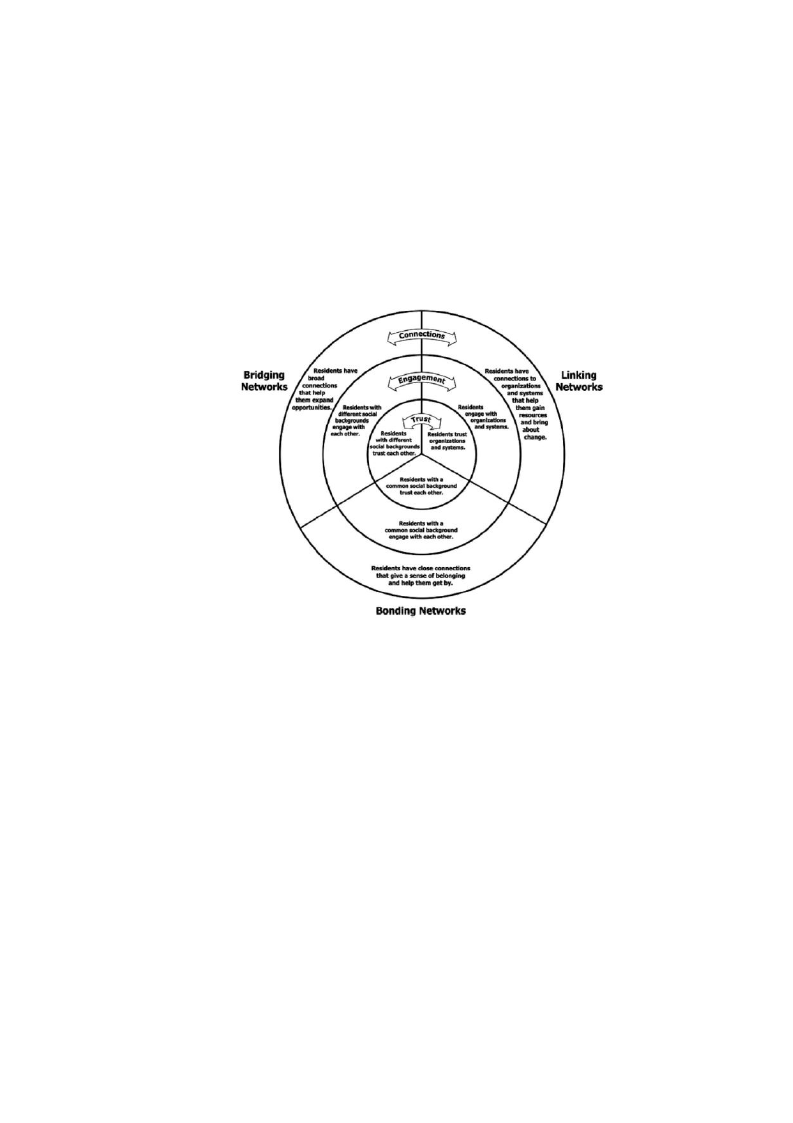
Figure 1 shows a community Social Capital Model developed by Chazdon and Lott (2010).
This focuses on how communities can improve their Social Capital by strengthening their residentsÕ
trust and engagement within three distinct networks: bonding, bridging and linking. Linking networks
are defined as networks and institutionalized relationships among unequal agents. Compared with
bridging, which connect individuals or groups who are not alike but more or less equal in terms of status
of power, linking networks are based as explicit vertical power differentials. These vertical connections
to organizations and systems help residents gain resources and bringing about change. Linking networks
is thus a third category of social capital to measure community strength.
Figure 1. Community social capital model (Chazdon & Lott, 2010).
3.4 Ecopsychology
ÔPsychology, so dedicated to awakening human consciousness, needs to wake itself up to one
of the most ancient human truths: we cannot be studied or cured apart from the planetÕ (James
Hillman).
Ecological psychology or ecopsychology Òfirst defined by Theodore RoszakÓ is a term for the
emerging synthesis of psychology and ecology (Hibbard, 2003). As a type of psychology, it seeks to
comprehend humankindÕs interrelationship with the natural nonhuman world, to diagnose what is
wrong with that interrelationship and to suggest paths to healing (Roszak, 1995). Ecopsychology grew
out of the environmental movement, which began in the 1960s in response to the dawning recognition
that modern industrial civilization had engendered an environmental crisis (Hibbard, 2003).
Studies suggest various definitions of ecological psychology: according to Winter (1996), it is
the study of human experience and behaviour in its physical, political and spiritual context in order to
build a sustainable world. Kinder (1994) defines ecopsychology as a study which explores how our
psyche is influenced by our environment as well as the environmental conditions influencing the way
we think and feel, treat nature and other creatures around us. According to Kindler, ÔEnvironmental
psychology is typically concerned with the effects of particular environmental conditions, such as stress,
13

pollution, noise, urbanization, crowding, and so forth, on individualsÕ (Kinder, 1994). By definition
ecopsychology aims to understand the ecological crisis from a psychological perspective (Hibbard,
2003). Taking into account all the mentioned definitions, ecopsychology aims to explore the
interrelations between human and nature relative to ecological crisis as it grew from it (Hibbard, 2003)
Scull (2008) discusses how actions towards nature need to be changed to overcome the existing
psychological alienation from the natural environment (Scull, 2008). Thus, ecopsychologists mention
that improving the relationship between human and nature happens on several levels (Hibbard, 2003;
Scull, 2008). One of those levels of ecopsychology is the experiential learning, that is assumed to help
humans arrange or rearrange their emotional and spiritual connection within their ecological system
(Scull, 2008). More precisely, experiential learning can already begin in early childhood as a significant
life experience that might continue, e.g. in wilderness experiences.
It is difficult to indicate a clear place of ecopsychology along other disciplines, as it has the
potential to break down barriers between many contrasting approaches to the human-nature relationship
and can be located at the intersection of three different dimensions, as illustrated in Figure 3. Indefinite
boundaries between ecopsychology and neighbouring disciplines appear.
To resume ecopsychology as a discipline, it has to be mentioned that it is a mixture of
experiential environmental education, natural history, and science. One can learn about nature and
ecology through attentive contact with the natural world (Scull, 2008). Building on a foundation of
direct experience with nature, ecopsychology is about formulating a language and set of models of the
human-nature relationship (Scull, 2008).
Figure 2. The position of ecopsychology in relation to other sub-disciplines. The boundaries are
vague and ecopsychology is informed by all these neighbouring fields. (Scull, 2008).
In ecopsychology people coexist in a cycle of life, like other organisms, and are directly
confronted with the physical world and not just mental constructs (Chawla, 2007). Furthermore,
ecopsychology suggests and describes that individual psychology takes place when people learn
through movement and exploration, such as children growing up close to nature or through playing
outdoors. Therefore, being a human means being involved in constant movement (Gibson, 2000). Under
ideal conditions children and adolescents discover the world through a wide range of movements in the
place where they live and in nature, since the natural environment plays a crucial part in this experience.
14

For learning and exploration, nature is a good playground and field of study since nothing
happens twice in the natural world (e.g. the chemistry of water) (Chawla, 2007).
By seeing people first and foremost as moving organisms in the environment, ecopsychology
sees them as a part of a relational system (Hibbard, 2003). Ecopsychologist Gibson (1979) suggested
the concept of affordances, which describes the properties of the environment that are described by the
relationship between the environment and other organisms. According to his concept affordances lay in
the relationship between nature and human-beings. Focussing on the subject of the paper the example
can be as follows: a wave has a certain shape and thus, allows a surfer to surf on it. This example relies
on the logic from Heft (1988). Therefore, it is about all creaturesÕ ability to take advantage of the
resources that the environment holds. Success depends not just on the qualities of the environment, but
equally on the biological systems that creatures have evolved to detect and use information about these
qualities, as well as the particular capabilities of individual organisms. Of course, the level of
affordances provided to humans are very different depending on the living conditions (Kytta, 2004,
2006).
Various studies (Chawla, 2007; Arnold, 2009; Sivek, 2002; Bymer & Gray, 2009; Gibson,
2000) define stronger connection with the nature in adolescence stages for those who were raised in a
less urban setting and had strong role models (parents, care givers, teachers), taking care of the
environment around them by action (Chawla, 2007) or by significant life experiences (Arnold, 2009).
Significant Life Experiences (SLE) are associated with pro-environmental attitudes and behaviour. It
was found that environmental leaders attribute their involvement in environmental action to spending
time outdoors, with parents, peers and teachers or reading books on relevant topics, e.g. environmental
destruction. The majority of the influences mentioned in SLE researches participants developed in their
childhood or adolescence and involved passionate role models such as parents, caregivers or teachers
(Chawla,1998; 2007; Sivek, 2002; Arnold, 2009). Previous researchers suggest that parents were
formative for all participants. Supportive parents were consistently present, but only this factor was not
enough to translate interest and values into action (Chawla 1998,2007; Sivek, 2002; Arnold, 2009). For
most people, the caregivers who first introduced them to the world remain their examples of what to
notice in the environment and how to respond to it (Chawla, 2007).
It is studied that adults who are the role models pay attention to the environment in four ways:
seeing land or water as a limited resource essential for family identity and well-being; by disapproving
of destructive practices; by experiencing pleasure while being out in nature; and through their own
fascination of earth, sky, water and living creatures (Chawla, 2007). The same people who taught care
for the land or water were also likely to express disapproval of other peopleÕs destructiveness, and when
they showed fascination with the details of things, it underscored lessons about the value of family land
or attitude to the natural water they use for familyÕs well-being, or general expressions of pleasure at
heading out into forests or fields (Arnold, 2009). By this ecopsychology explains the influence of close
role model caregivers on further attitude to nature or environmental activism.
The final principle of ecological psychology which helps to explain the formative experiences
of environmental activists is the importance of learning about the world first hand through oneÕs own
actions in it, rather than second hand when others represent it. Reed (1996) calls it Ôthe necessity of
experienceÕ. Outdoors especially, a person encounters a dynamic, dense, multi-sensory flow of
diversely structured information, but some places are richer in this regard than others. For that reason,
Reed (1996) suggested that the level of closeness to the nature or the access to affordance during the
development of a child is of importance due to the fact that it will influence the future exploration and
interconnection and care for the environment in adolescents, despite the influence of significant adults.
Primary experience is also necessary because it occurs in the real world of full-bodied experiences,
where people form personal relationships and attachments. This increases the motivation to protect the
15
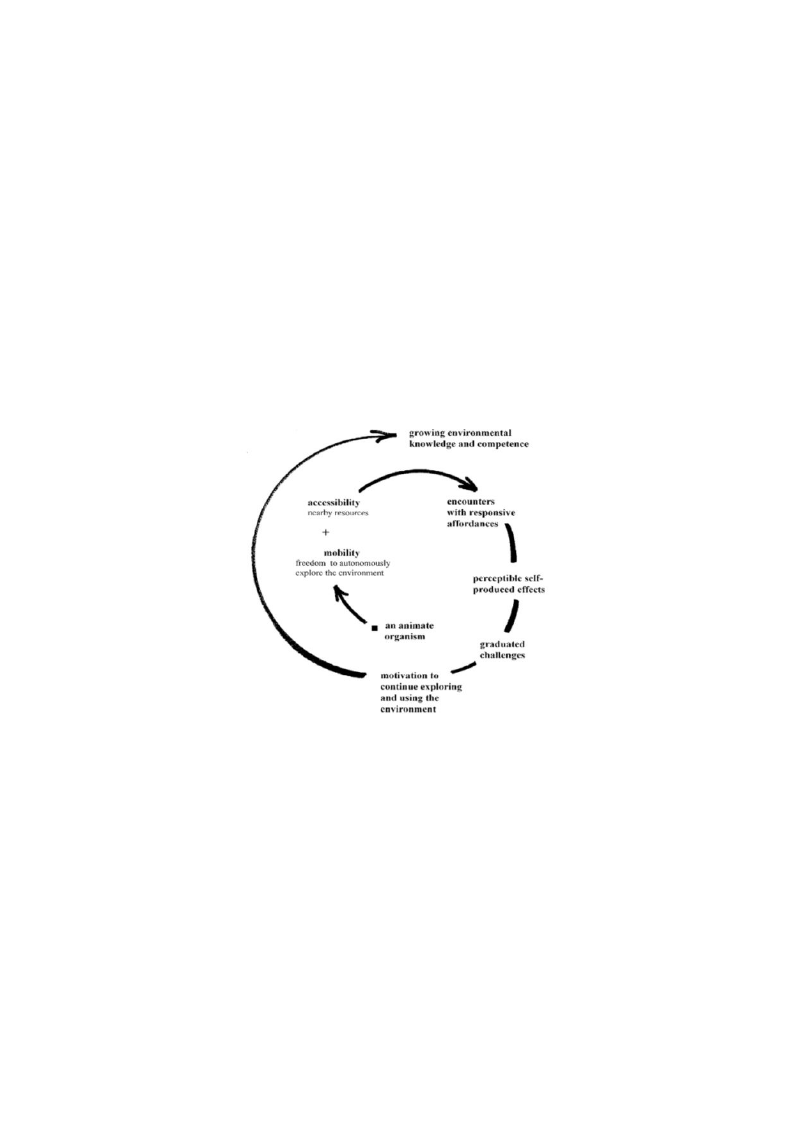
surroundings, people they love and to build competencies and communities to do so (e.g. to protect the
river they grow up close to or to save the park from buildings) (Reed, 1996; Chawla, 2007).
Chawla (2007), suggests the positive interactive cycle of a human engagement with the
environment to support the principles of ecopsychology. As it is shown in Figure 3, the positive
interactive cycle starts with an animate organism who is human and has the ability to be mobile (e.g.
free to explore the environment autonomously) as well as the access to that environment. This is the
base to start the experience of interaction with nature. To proceed with a deeper exploration one (or an
animate organism) needs a certain level of affordances (as it was mentioned before with the branches
of the tree or the waves example). When the interaction happened in a satisfying way and gave some
further challenges to overcome there is a motivation to explore further, which positively leads to
growing environmental knowledge and competence (Chawla, 2007). The cycle presents the ground for
the human-nature interaction and can be interpreted broader than the focus on environmental activism.
However, this research will use the cycle to display the work of principles of ecopsychology in the
surfing community.
Figure 3. Interactive cycle of human engagement with the environment (by Chawla, 2007).
Last but not the least principle of ecological psychology relates to the value of organisations,
which environmental activists also credited as important influences in their childhood and youth
(Chawla, 2007). Barker (1968) developed the concept of Ôbehaviour settingsÕ, which are the customary
patterns of behaviour in designated places where people gather to engage in particular activities at
particular times (Chawla, 2007). These settings are constituted by the coordinated actions of people as
well as the affordance of the place. According to Barker (1968) these settings are influential for further
environmental activism. However, the base of affordances or role-models in a positive interactive cycle
are usually the factors that are deeply-rooted (Chawla, 2007).
Putting these principles of ecological psychology together, they illustrate how formative
childhood experiences, role-models and settings that a person experiences are to have a stronger
interconnection with nature, which eventually leads to more powerful environmental values and care.
16

4. Methodology
4.1 Research design
This thesis is conducted with a qualitative and inductive research approach. Qualitative research
is an umbrella term for a variety of approaches and strategies for conducting research aimed at finding
how human beings understand, perceive, interpret, and experience the social world (Campbell &
Hammersley, 2012). This research will be mainly concerned with the analysis of the complex,
contingent, and context-sensitive character of social life. Moreover, the analysis will observe actions
and outcomes, which are produced by people that interpret situations in different ways, and act
individually on the base of these interpretations. The logic behind the inductive approach is that
generalisations will be made about behaviour observed in a specific context or situation. In this instance,
the gathering of data is used to explore a phenomenon, identify themes and patterns and create a
conceptual framework (Saunders et al., 2012). This paper introduces research questions to define and
narrow the scope of the study. Further the research questions aim for objectives that shall be achieved
during the research process. There is no theoretical frame for successful motivators in grassroots
initiatives in surfing communities, yet. Therefore, this will be explored by identifying patterns at
existing and developing surfing communities in Ukraine and Germany. The theoretical framework (SC,
SL and ecopsychology) is used as an analytical lens. The analysis will be followed by a discussion
which will include recommendations for practice and further research. Eventually, the findings of the
thesis will be summarized in a conclusion.
The chosen method in the research is semi-structured interviews, where interviews are
conducted to understand the socially constructed world of research participants (Ritchie et al., 2014).
This was chosen due to the conversational style, which is often relevant for learning about motivations
behind peopleÕs behaviours and choices, their attitudes and beliefs, and the impacts on their lives of
specific policies or events. Semi-structured interviews often provide valuable information that was not
anticipated by the researcher (Raworth et al., 2012). In the thesis, 10 semi-structured interviews with
open ended questions were used, as it allowed the flexibility and depth of responses (Wiles, 2005).
These interviews were composed of a total sum of 12-40 questions, that were specifically adapted to
the individual background of the intervieweeÕs role in the surfing community. The noticeable difference
in interview-questions shows the individual approach to each interviewee, which indicated another
advantage of semi-structured interviews, which is the freedom it gives to the interviewees when
answering questions in their own frame of reference without being restricted by leading questions from
the interviewer (Wiles, 2005).
The semi-structured interviews were conducted and analysed by the authors themselves and
thus belong to primary data, which is generally understood to be the initial data specifically collected
by the original researcher concerned about the research problem. The literature review will be the
secondary data, understood as a portrait of data gathered from previous studies by a number of relevant
researchers (Heaton, 2004). The findings from the literature will be presented result-based and focused
on recent developments in the research field in the sections ÔintroductionÕ, ÔcontextÕ and Ôprevious
researchÕ. Therefore, the research will be approached by three modalities: by gathering formal data from
publicly available data, by collecting informal data shared between researchers and by accessing oneÕs
own data. By using all three approaches, the team of researchers aim to answer the research question at
micro (individual) and macro (societal) level.
The focus of this research is based on two countries - Germany and Ukraine, where surfing
communities exist and can therefore be compared and examined. Hence, the authors interviewed 10
surfers from both countries: 3 Germans and 7 Ukrainians with different levels of involvement in GRIs,
17

surfing communities and environmental activism to collect the primary data for the research. The total
sum of 10 interviews was chosen due to the predefined guidelines by Malmš University.
4.2 Collecting data
The ten interviewees were selected and consequently contacted through social media and email.
The main criterion for the participation in the interviews was the level of involvement in surfing
communities in Germany or Ukraine, as well as their participation in the IOSF, which was relevant
solely for German interviewees due to the fact the USC has not yet been formalized as a GRI. Gender
and age of participants was not taken into account, however, the place of living and growing up was
considered due to the theoretical framework of the paper. Ukrainian interviewees were found through
the USC groups in social media. German interviewees were found and chosen due to their involvement
in relevant IOSF and local surf clubs.
The structure of the semi-structured interviews was the following: after explaining the purpose
of the interview and research, questions regarding the intervieweesÕ personal details (nationality, place
of living etc.) followed. Afterwards, the interview was designed to continue with more detailed and
open questions to obtain a deeper view on the participants opinion about relevant subject areas. The
first questions were focused on the intervieweeÕs previous experience in surfing and also tackled the
reasons of involvement with the sport and connections with the nature of a particular interviewee. Then
a variety of questions followed that enabled the interviewer to understand the level of involvement in
IOSF (was relevant only to German interviewees). The interview questions were designed according to
a chosen model of GRI motivators by Grabs et al (2015). The model was described earlier in the paper
and provides an understanding of which factors have to be taken into account for societal change in a
developing GRI. As the focus of this paper is the interconnection of influences on individual and societal
levels on GRIs, the interview questions were formulated accordingly. Particularly the questions were
composed to find out how the individual involvement of a surfer with the IOSF is constructed and which
reasons for the involvement exist. Just as important for the research are the effects of the societal
conditions and political support on the IOSF. The questions were also rooted in the ecopsychological
theory to provide an overview of the participantsÕ involvement in surfing through their connection with
the nature.
One interview was conducted in person. The environment was chosen in a public environment
to make the interviewee feel as comfortable as possible to create a friendly and trustworthy atmosphere
(Flick, 2018). The additional nine interviews were then conducted via telephone or video-call, since the
interviewees are not living in Sweden, where the research was conducted. Each of the interview got
audio-recorded and then transcribed (Flick, 2018). Firstly, the transcript was authored in the native
language of both interviewer and interviewee, secondly, the interviews were translated to the language
of presentation. Whilst Flick (2018) describes different approaches to presenting translated findings
bilingually, the authors of the thesis will present findings coherently only in the language of
presentation. The answers of the interviews were used for an analysis by coding and categorizing the
collected data. The exact composition of the 10 interviewees by code, gender, country, organisation and
role is described in Table 1.
18

Table 1. Overview of 10 Interviewees from Germany and Ukraine
Interviewee
1 German
interviewee 1
2 German
interviewee 2
3 German
interviewee 3
4 Ukrainian
interviewee 1
5 Ukrainian
interviewee 2
6 Ukrainian
interviewee 3
7 Ukrainian
interviewee 4
8 Ukrainian
interviewee 5
9 Ukrainian
interviewee 6
10 Ukrainian
interviewee 7
Gender Country Organisation Role
Interview date
m
Germany IOSF
Founder of the Berlin
chapter of the IOSF,
activist, surfer
April 26, 2019
m
Germany IOSF
Founder of the Berlin
chapter of the ISOF,
activist, surfer
May 8, 2019
f
Germany Local surf club Board member, youth May 13, 2019
on a German leader, surfer
island
m
Ukraine /
Surfer
May 8, 2019
m
Ukraine /
Surfer
May 10, 2019
m
Ukraine USF
Surfer
May 9, 2019
m
Ukraine USF
President, Surfer
April 23, 2019
m
Ukraine /
Surfer
May 8, 2019
m
Ukraine /
Surfer
May 14, 2019
m
Ukraine USF
Co-Founder, surfer
May 14, 2019
4.3 Data analysis
The interviews are analysed with a narrative approach, which refers to any study that uses or
analyses narrative materials, where narrative is defined as Òa discourse, or example of it, designed to
represent as a connected succession of happeningsÕÕ. It may be used for comparison of groups, to learn
about a social phenomenon, or to explore a personality. It is often used for the analysis of conversations
or life stories obtained in interviews. The narrative is used to represent the character of a lifestyle of
specific subgroups in society which are usually unheard, by exploring their subjective and inner
experience on a relevant issue. (Lieblich et al., 1998). The narrative analysis thus bears great potential
for gathering contemporary beliefs, individual and collective opinions and perceptions of culture
(Alvesson, 2010).
Thus, the analysis will be focussed on comprehending the character of the specific subgroups
of surfers and GRI participants by exploring the collected data through the theoretical lenses. In the
final analysis the authors of the thesis will further study contemporary beliefs, by analysing determined
19

themes, in section 5.2. The themes Ôself-efficacyÕ and ÔtrustÕ were chosen due to their apparent
significance.
4.4 Research reliability and validity
Reliability is the degree to which the finding is independent of accidental circumstances of the
research, and validity is the degree to which the finding is interpreted in a correct way. Social science
has relied almost entirely on techniques for ensuring reliability, in part because Òperfect validityÓ is not
even theoretically attainable (Golafshani, 2003).
The question whether the method and findings of the study are replicable and if future
researchers will achieve the same results and interpretations, is within the discourse of reliability
(Golafshani, 2003). Conducted interviews therefore address the topic of reliability by having particular
patterns to compare and match the participantsÕ answers within a clear research process and analysis
method. Theoretical transparency is further presented through the theoretical framework given in the
paper.
The validity of research describes the extent to which a study may be useful for other researches.
Therefore, the validity of this study lies within approaches for analysing surfing movements and their
potential for GRIs. The approach was presented in the structure of the interview questions, which was
based on the principles of ecopsychology as well as the model by Grabs et al. (2015) with the focus on
societal and individual motivators for GRI. Conclusion validity means the extent to which the data
supports statements which are made based on analysed patterns, so that it is not reasonable to draw a
general conclusion from just one individual intervieweeÕs answer, rather there is a legitimate theoretical
framework to ground the data into theory and to show the interconnections in order to generate helpful
conclusion.
The science of philosophy of this thesis refers to the ontology and epistemology, which
comprises the beliefs or assumptions of the reality (ontology) and the gaining of knowledge and
relationship between research participant and researcher (epistemology) (6 & Bellamy, 2012).
Therefore, the approached used in this research paper is based on an ontological position
referred to as constructivism, where knowledge is constructed through interaction with other people
(personal experience) (6 & Bellamy, 2012). This approach is found compatible with the subject of
surfing movement and its potential to become a GRI as the perspectives of representatives of surfing
communities and personal experiences on the topic were the basics of the findings of this research.
The authors of this thesis are aware that there is a possibility for multiple interpretations and
deductions of the data, knowledge and the additional information provided in this academic paper due
to individual differences and multiple perspectives, as according to Rodwell (1998) constructivism is
never final or absolute.
4.5 Research limitations
Due to the timeframe and the focus of this study, this research paper implies several limitations.
The geographical limitation is acknowledged as the study focuses on Germany and Ukraine. This is
suboptimal when contacting the interviewees and conducting the interviews. Initially, all the active
members of IOSF from EU-countries were chosen to be interviewed to have a bigger scope of research
comparison. But due to the timeframe and the level of responsiveness, the authors of the thesis opted to
research Germany and Ukraine for a deeper comparison and exploration.
Besides the geographical limitation, another drawback of this study is the gender imbalance
within the participants. As the criteria for the interviewees was mainly the level of involvement into
20

surfing and respective IOSF, the authors did not take into account the gender gap in surfing sport and
out of 10 interviews 9 participants are male and 1 female.
One more critique of the research could lay in the narrow scope of the interviewees. As the
authors focused on surfing communities, logically the representatives of those who were interviewed in
the countries of the studyÕs focus - Germany and Ukraine are members of that community. It would
have been insightful to also gather opinions of ecological experts and representatives of local
governmental agencies and political parties in regards to the research questions.
As well as more attention and further research could be dedicated to the extent and influence
of a welfare state on activism and its interconnections.
A strength of the research is the collection of data from two different countries, Germany and
Ukraine, in the respectively native languages of both the interviewer and interviewees. The researchers
chose to proceed that way to respect the cultural affiliation. Partly, the native languages were chosen
due to the lack of knowledge of English as a foreign language and mostly because of the interview
participantsÕ, whose input to the focus of study was relevant. Consequently, the translation was
conducted by the interviewers to provide the gathered information for all the authors of the thesis.
Accordingly, collected data might miss some of the nuance expressed in the native languages of the
interviewees, or mistranslated to some (small) degree by the authors of the thesis.
5. Analysis
The ten interviews that were conducted with German and Ukrainian surfers revealed antecedent
findings. These findings and statements from the interviewees will be presented and interconnected to
point out parallels and inconsistencies in regards to the chosen theories and background. The first
paragraph will examine how far the interviewees confirm or dissent with the given argumentative
structure of the thesis, that is based on the argumentation for the importance and trend towards local
GRIs and furthermore, that surfing communities bear great potential for environmentalism (activism)
due to their closeness to nature. These theoretical arguments will be linked to the collected data.
Further, the analysis will devote paragraphs to each theory described in previous segment 3,
ÔTheoretical frameworkÕ. More specifically the collected data will be analysed through the lenses of the
chosen theories. First, the SL theory will be compared with the transcripts and relevant citations will be
presented and explained. Second, the SC theory is going to be utilized to locate vital statements within
the collected data, to highlight the SC components within surfing communities in Ukraine and Germany.
Third, as the theoretical framework shows, the ecopsychology theories are an essential basis for
argumentation in this thesis, therefore the ecopsychological elements will be highlighted and analysed
with a sharper focus. The additional paragraphs will present the Ukrainian political context for activism
and a description of the surfing community, as it is currently (2019) found.
The analysis will then further explore themes that were developed after the data was collected.
These themes are ÔtrustÕ on a societal level and Ôself-efficacyÕ on an individual level, which will look
more specifically into the use of language and wording of the participants for further discussion.
5.1. Antecedent findings
Seyfang & Smith (2007) mention that GRIs facilitate beneficial intrinsic development for
individuals and diffusion opportunities. Hence, notable intrinsic changes were observed. German
surfers described that they grew as a person by learning to coordinate people, overview responsibilities
and enhance knowledge and skills, such as improve in holding a speech or creating innovative events
to raise environmental awareness. Their level of confidence increased by having a sense of belonging
to a community, that acts collectively and shares visions. Finally, German surfers mentioned that since
21

they became a part of the GRIs they started to be more faith- and hopeful to make a difference in their
community. Thus, this reflects one of the individual changes, such as greater civic engagement (German
Interviewee 1; 2; 3). Some diffusion factors were also present. A German surfer discussed how the local
group of the IOSF, in which he is active, succeeded in raising awareness about a plastic free lifestyle,
when people were critical at the beginning, but inspired and interested at the end of the event or
conversation (German Interviewee 3). Awareness-raising projects were prominent, since all German
surfers mentioned being involved with a lot of volunteers around the community and country supporting
sustainable development through their GRIs (German Interviewee 1; 2; 3). In contrast to an earlier
finding (Seyfang & Smith, 2007), however, no evidence of altering mindsets of local policy-makers and
politicians was detected in the surfing GRIs. Nevertheless, the importance of awareness-raising and
individual changes through GRIs are considerable.
Various authors demonstrated that GRIs are functional for processes of niche development
(Ornetzeder & Rohracher, 2013; Seyfang & Smith, 2007; Seyfang & Haxeltine, 2012). A surfer who
previously volunteered for an international NGO with an environmentalism focus outside of the surfing
community mentioned that the NGO was great but did not reach out to people Ôseeking a certain
lifestyleÕ in the city. Moreover, he confidently mentioned that more people from his generation seek a
more niched kind of approach with events and approaches (German Interviewee 1). Another surfer
volunteering for the IOSF, mentioned that the organization approaches environmentalism through
cultural niches with information-stands at e.g. surf movie nights, which already attract the right audience
(German Interviewee 2). This aligns with the theory, which explains that GRIs are seen as niches of
experimentation of new social and cultural arrangements (Seyfang & Haxeltine, 2012; Seyfang &
Smith, 2007). In summary it can be said that German activists tend to foster networking activities by
engaging the stakeholders, which is one of the requisites for successful niche growth (Ornetzeder &
Rohracher, 2013). These findings strengthen the argument for a trend towards local GRIs.
In addition to that multiple interviewees agreed that surfing is becoming more popular globally,
but also on their local level (Ukrainian Interviewee 7; German Interviewee 1; 2). A Ukrainian surfer
assumes that in Ukraine, SUP and classical surfing is quite a young sport. Moreover, he states, that the
costs of buying equipment and traveling to surf-spots is a reason why not many people choose to surf,
due to limited financial flexibility. Nevertheless, he noticed a trend, a noticeable increase of popularity
when it comes as it becomes more accessible (Ukrainian interviewee 2). Multiple Ukrainian
interviewees mentioned the evolving/growing surfing community in Ukraine (Ukrainian interviewee 2;
5; 6). Therefore, it is assumed that these trends combined bear a great potential for environmentalism
within the surfing communities. More concretely, the strong feeling of attachment to nature, especially
the ocean, plays a key role in this development. As mentioned by German as well as Ukrainian surfers,
the affinity to nature is a powerful experience. Furthermore, a German surfer, who is active for an IOSF,
explains, that this nature-affinity did not appear through surfing, but rather, that his closeness to nature,
which he felt before, made him surf, because he wanted to experience the sensation of a human-natural-
connection. Therefore, it appears that more contemporary and local approaches for the alignment and
formation of GRIs and environmentalism through niches, such as surfing, create a stronger proximity
of the involved participants. The promising tendency will be further analysed in the subsequent
paragraphs.
22

5.2. Social Learning
A process of observational learning and the four involved components were noticed when
asking some interviewees if they were involved in environmental activism. German and Ukrainian
surfers are involved with communal Ôbeach clean upsÕ. This happened for them through a process: First,
they payed attention to people collecting trash at the beach. This image was retained by experiencing
the view of a clean beach scenery. Thereupon, as the surfers (the learners) internalised the necessity for
a clean beach they started to change their behaviour by cleaning the beach more often. Eventually, the
intrinsic motivation differs between the interviewees, as Germans keep seeing the incentives for it,
whilst the Ukrainians saw that the beach environment keeps being polluted by other people or
companies, that perform ÔconstructionÕ. As one Ukrainian surfer precisely mentioned, that in his
opinion, people do not have enough motivation to take action (Ukrainian Interviewee 7).
Even if SL states that learning starts eminently by observing, it does not always need to be like
this. SL can also be learned by doing. One Ukrainian surfer (Ukrainian interviewee 3) stated that he
does not consider himself an activist, though he acknowledges that there is something happening
intrinsically. He describes that he Òwill not go on strike or start a revolution.Ó, because he believes that
most importantly, it needs to start within oneself. He later on refers to himself as a Òcalm activistÓ, that
does not force his beliefs onto others, but rather leads by example (Ukrainian interviewee 3, personal
communication, May 9, 2019). Just as other Interviewees agreed and stated that they influence their
immediate circle of acquaintances. As a result, the change becomes situated within wider social units.
Germans involved with local chapters of IOSF mentioned that their interest in
environmentalism and activism was initiated through mass media and their awareness that was gained
as a result of that. More specifically, one of the involved surf activist said that ÒI think I got in touch
with this whole plastic topic and ocean pollution in 2011, when I read an article in a newspaper.Ó
(German interviewee 1, personal communication, April 26, 2019). For this to be considered as SL, as
described by Reed et al. (2010), three stages need to take place. The first, was the described scene, of
understanding a topic on an individual level. This phase described is one-directional, where the
characters receive information. Followed by the next step, which is the stage where multiple
interviewees from Germany and Ukraine explain, that they have already influenced family, friends and
people close to them (Ukrainian interviewee 1,2,6), this implied that wider social units have learnt,
mainly because the wider circle has realized that the overall living conditions will benefit from these
changes (e.g. less garbage in the neighbourhood or on the beach implies that everyone will have an
advantage from a better and cleaner environment. Therefore, the level of multi-directional learning was
reached, when mentioned interviewees founded a local chapter of the IOSF to engage in environmental
activism in their local environment. The chosen organizational structure of direct democracy shows that
the individuals aim for a collective learning experience to Òoptimise the collective well-being of current
and future generationsÓ (Gough et al., 2017).
Not everyone is necessarily influenced by a certain person, when it comes to increased
awareness about environmentalism. German interviewees were influenced by mass media, which bears
potential to consequently influence acquaintances, relatives and proximal individuals with their own
beliefs (German interviewee 1; 2). Meanwhile, for Ukrainian interviewees it is unlikely being
influenced and educated about environmentalism by mass media. A Ukrainian surfer mentioned that
they are far from being environmentally active, as he said Òpartially because of the information we are
surrounded with, I mean, monitor our media: they are all about corruption and war, and pensions and
aging of the nation. There is basically nothing about the climate change or a plastic-free lifeÕÕ (Ukrainian
interviewee 6, personal communication, May 9, 2019). Another Ukrainian surfer agreed and assumed
that there is huge potential in Ukraine, because he sees various environmental threats, whilst he also
23

witnesses ignorance and suppression because of Òmore burning issues, like elections, war or religionÓ
(Ukrainian interviewee 2, personal communication, May 10, 2019). These results are similar to those
reported by Turchenko et al. (2017), explaining how Ukrainian media does not inform or educate about
climate regulations, nor raises awareness among the population, due to more important issues like
social, political and military events.
5.3 Social Capital
A Ukrainian that is part of the USC does not define himself as an activist. Yet, him and his
family engage in actions on a local scale. ÒWe go out on Saturdays to the events of local importance
(like beach clean ups or neighbourhood clean ups). And itÕs all organized and the initiative of our
neighbours or some active citizens of the neighbourhood.Ó (Ukrainian interviewee 2, personal
communication, May 10, 2019). He also mentions how schools do not thematise topics like recycling
and the need to protect the environment, so him and his wife decided to educate their children
themselves. Moreover, he stated, that for their children environmentally friendly behaviour, like picking
up trash comes naturally already. He adds that in his perspective activism is not about signing petitions
or going to strikes, but more about conscious consumption of the resources and raising awareness about
those topics, at least to oneÕs children and the closest acquaintances (Ukrainian Interviewee 2). Roger
Barker (1968) described the Ôbehaviour settingsÕ, where the importance of an influencing organisation
is described in early childhood and youth (Chawla, 2007). This describes the phenomenon that the
Ukrainian surfer (Ukrainian interviewee 2) explained. The neighbourhood actions, for him, do not feel
like activism, yet, they influence future generations and create an impact. From a perspective of
ecopsychology, these neighbourhood-actions create a closeness to the immediate environment and
promote a sense of responsibility. A sharp presence and interconnection of SC and ecopsychology
exists. As Flora and Fey (2004) argued, communities with high levels of bonding and bridging network
will be engaging in effective action as an outcome. In this case, the relationship between families
(bonding network) and between the neighbours (bridging network) is strong and that is why there is a
high degree of community action.
When a social network forms, trust is supposed to build up, Paldam (2000) explains and
introduces the Ôtrust-cooperation complexÕ, which suggests that SC stands for the quantity of trust that
an individual has with other individuals within their community and wider society. In contrast to that,
multiple interviewees were not entirely agreeing. Their extensive awareness about the climate crisis,
plastic waste in waters and on the beaches and the certain environmental effects, creates only a limited
amount of trust. Simultaneously, interviewees feel very disappointed in societies and humanity in
general, even though within their circle of activism they feel a certain degree of trust among their peers,
members, relatives etc. (German interviewee 1; 2; 3). The Ukrainian surfers shared that people who
were not raised or lived near the coast did not understand the value of nature and used to harm the area
by polluting it, so it seemed that their level of trust was also not really high (Ukrainian interviewee 1;
4; 7).
The so called Ôthird party involvementÕ (Paldam, 2000), describes the legal and political
environment that either favours or overcomplicates the formation of GRIs within a country. All German
interviewees agreed that Germany is an ideal place for GRI formation despite not completely agreeing
about political seriousness about long-term actions towards environmental protection and policies
(German interviewee 1; 2; 3). The mentioned conflict is characterized as one of the necessary
motivators for empowering GRIs in niches, such as surfing communities (Ornetzeder & Rohracher,
2013; Seyfang & Smith, 2007; Seyfang & Haxeltine, 2012). As opposed to this, the Ukrainian
interviewees criticize a holistic absence of environmental policies in the political circles (Ukrainian
24

interviewee 2; 3; 6; 7). Moreover, Kj¿lsr¿d (2013) argued that societies are more improbable to only
rely on political unions and parties to act but would instead become active themselves. As the interviews
with Ukrainian surfers clarified, this assumption shall not be adapted to any national context, without
further investigation, since it does not holistically apply to their experiences. Surprisingly, the German
interviewees declare that an adjuvant national context for activism and GRIs movements is present due
to their feeling of safety and support from the state. The further Ukrainian context of Ôthird party
involvementÕ will be further elaborated in Ô5.6.1 TrustÕ.
5.4 Ecopsychology
Multiple Interviewees from Ukraine and Germany grew up by the ocean (or the sea, in
Ukrainian context) (German interviewee 1; Ukrainian interviewee 1; 2; 3; 4; 7). A German surfer, who
grew up on an island, mentioned that she feels a strong connection to the ocean and adds, that water is
her element (German interviewee 3). Chawla (2007) explains that children, as well as adolescents, learn
and experience the world at the place where they live and grow up through the movements they make,
which function as a field of study. These naturally occurring processes of learning can happen through
the exploration of nature and the bare movement within the coastal environment (Chawla, 2007). Given
the explored context of the thesis, the surfers that grew up by the coast, as well as the surfers, that
nourish their connection to the natural world by spending much time there, take part in this exploration
and process of learning and therefore, nourish their connection to nature to an extended degree.
Various interviewees talk about a very deep and ever-present connection to the ocean or sea
(Ukrainian interviewee 1; 2; 3; 6). Moreover, one interviewee adds that Òwhile surfing, doesnÕt matter
if you are catching the wave or just enjoying the still water or the sunset, you kin[da] connected to
something bigger than just water or the beachÓ (Ukrainian interviewee 3, personal communication, May
9, 2019). This statement reassures the strong connection to the ocean/sea. Strongly agreed by a fellow
Ukrainian surfer, who stated that he also feels the sensation of belonging to something bigger, when he
surfs (Ukrainian interviewee 7).
A Ukrainian interviewee added the closeness of people living in a maritime environment, that
did not necessarily grow up there, but chose to live there. The same interviewee explained that people
who live on the coast, they feel dependent on the sea and understand the value of the sea (Ukrainian
interviewee 4). Therefore, the interviewed surfers agree on a special connection to the ocean/sea and
environment, which supports the ecopsychological statement that people who grew up in a less urban
settings or had a significant life experience (e.g. with the sea in this case) are more prone to take care
of the nature and value it stronger (Chawla, 2007; Arnold, 2009).
As it was presented in the theoretical background of the paper, Chawla (2007) suggests the
Ôpositive interactive cycle of human engagement with the environmentÕ in order to support the
principles of ecopsychology. In that cycle, humans have to pass through steps of interaction with nature
to gain a deep level of knowledge and competence. According to the cycle (Chawla, 2007) one needs
to have access to nature and the mobility to explore it as a base to start experiencing the interconnection
and interaction, as well as the level of affordance (relationship between the environment and other
organisms), with it. When the interaction happens, the strength of natural powers can be challenging
but also motivational to overcome the challenges in order to explore further. The deeper exploration
can lead to gaining environmental knowledge and competence. According to the data from the
interviews all the participants had unique experiences and interactions with nature. Surfing was either
the initial stage of it, a part of it or the result of the previous interaction. The access the exploration of
nature was explained by Ukrainian interviewees saying that while growing up by the sea it was
inevitable for them to end up as a surfer (Ukrainian interviewee 1; 3). Concluding the access and
25

mobility of those who grew up at the cost was obvious and inevitable: ÒI started in my childhood from
various attempts, because I lived by the sea and always wanted to do something marineÓ (Ukrainian
interviewee 2, personal communication, May 10, 2019). Challenges which appeared after the interaction
with nature were named as the struggle to obtain the participantÕs surfing skills (Ukrainian interviewees
2; 3; 5). Surfing as a sport or a leisure activity needs dedication and permanent practice. Therefore, the
surfers explain that they have to interact with nature constantly to overcome the challenge of losing
skills, in order to improve their surfing performance and satisfaction (Ukrainian interviewees 2; 3; 5).
A Ukrainian interviewee assumes that surfers do not usually discuss or share their deep connection with
nature and the ocean with others (Ukrainian interviewee 1). Though, for the German interviewees the
concept of sharing is different: Òyou talk about the waves and the strength of the ocean [...] So I think
that's communicated among friends, at least surfer friends (German interviewee 1, personal
communication, April 26, 2019). The level of sharing and exchanging the experiences can be different
in the surfing communities and is an individual feature, rather than one assigned to a surfing community
in general.
All of the interviewees expressed their involvement in surfing by building a stronger connection
with nature (those who grew up at the coast) or reconnecting with it (those who were living in the urban
settings). As mentioned previously, they did not reflect on the experience and felt like surfing was an
obvious hobby to have while growing up or living close to the coast. Those, who were distant from the
sea for various reasons wanted to establish the connection with nature after living in an urban
environment again and surfing became a tool: ÒI assume, this is my desire to reconnect with the nature
again. [Cos] I live in a big city, in block of flats with my family. We do not even have a garden. So, I
made surfing kind of my purpose to travel to the sea more often and also to show the example to my
daughters, who are also already involved in this sportÓ (Ukrainian interviewee 6, personal
communication, May 14, 2019). The surfer mentions multiple motivators to make surfing a tool: his
living conditions, his immediate urban environment and his desire to reconnect with nature. Something
similar is mentioned by a German surfer, engaged in a local surfing club where she acts as the youth
leader, namely that she always needs to come back to the sea and live close to the water (German
interviewee 3).
However, some of the surfers did not have a direct goal to re-establish their connection but
obtained it after engaging into surfing sport: ÒI was born in Shostka, Sumska oblast. There was no sea,
of course. There were rivers and lakes. But I grew up in very urban conditions. We lived in a block of
flats [...] So, basically, I didnÕt have that marine connection or a dream. I obtained it later, when I started
to surfÓ (Ukrainian interviewee 5, personal communication, May 8, 2019). Once again, the perceived
conflict of the urban environment was mentioned, which led to the desired connection to a more natural
environment.
5.5 Ukraine: Political context
A Ukrainian surfer explains that Ukrainians in Odessa, where he resides, are busy with meeting
their basic needs. Interestingly, the interviewee mentions MaslowÕs Pyramid4 to refer to his perceptions
about basic needs and other psychological or safety needs. He says that in the conditions they live, it is
not logical to expect any high activistic impulses from people, and the authorities are advantageous
enough for people to be able to satisfy their basic needs such as nutrition, housing or paying rent
(Ukrainian interviewee 1).
4 Maslow’s Pyramid of needs (1943) is an hierarchical approach to human motivation including bottom
to top: immediate psychological needs, safety, love, esteem and self-actualization (Kenrick,
Griskevicius, Neuberg, & Schaller, 2010).
26

Different surfers agree that being employed and receiving a reliable incomes allow them to surf
and follow this interest. Thus, they assume that the high costs of surfing as a hobby is the reason why
it is not considered entirely accessible in Ukraine. Moreover, a lack of understanding is described
concerning knowledge about the health benefits of this leisure activity, which is just as advantageous
as wholesome food and a healthy lifestyle, interviewees describe. Another line of thought argues that
the lack of activism refers to the general lower level of wealth in Ukraine, stressing that while having a
stable income one can be more dedicated to hobbies like surfing or follow any other priorities, but this
is not applicable for the majority of the Ukrainian population (Ukrainian interviewee 2; 3). Another
interviewee suggests that environmental activism starts when basic needs are steadily covered, so that
the population has capacities for developing an awareness about climate change and other
environmental topics, because momentarily there are Òmore important things they have to care aboutÓ
(Ukrainian interviewee 3, personal communication, May 9, 2019). The interviewee is one more time
referring to food and housing while stressing that climate change awareness is not considered a basic
need (Ukrainian interviewee 3). Another participant adds that there is no prevalent understanding or
present mindset of prioritizing ecology and an ÔecoÕ lifestyle, because nature is considered to be ÔgivenÕ:
Òat least in our country and we always used the resources and never were thoughtful of how to make
nature comfortable tooÓ (Ukrainian interviewee 5, personal communication, May 8, 2019). The
statement clarifies that the intervieweeÕs mindset has already shifted to being aware of the humanÕs
effect on nature and in reverse, the natureÕs need for protection.
In contradiction we have the statements of German activists (German interviewee 1; 2) that
describe the benefits of having more time for activism in times of uncertainties, e.g. finding a new job,
because the state support in Germany is strong enough to let them turn these times of uncertainties into
purpose-driven times, which for them meant to engage with the IOSF.
Moreover, a Ukrainian surfer mentions obstacles like the challenge to lobby against illegal
construction sites and further harmful issues initiated by official institutions, which slow down the
development of surfing. Interviewees agree and mention the difficulties of corruption one faces in
everyday and especially professional life (Ukrainian interviewee 4; 3; 6). Yekelchyk (2015) supports
these statements and approves that Ukraine has not managed to eradicate corruption. The president of
USF further adds that Òsometimes I feel like all of my efforts for the beach cleaning or attitude to plastic
have to be communicated horizontallyÓ (Ukrainian interviewee 3, personal communication, May 9,
2019). He describes the wish for support from official institutions and the government, instead of having
to facing obstacles and ignorance from these parties. Moreover, he mentioned repeatedly that the
political situation in Ukraine is not ideal for environmental focus and changes, because the government
has to deal with many urgent issues, including a war (Ukrainian interviewee 3). When mentioning the
ÔwarÕ he is referring to the armed conflict in the Eastern part of the country. He acknowledges that even
though not all regions in Ukraine were affected, it has been and still is very present all over the country.
5.6 Themes
For the advanced analysis, a relevant set of themes were selected to be further examined. These
themes were chosen due to apparent thematic accumulations in the transcripts. Moreover, the detected
themes of ÔtrustÕ and Ôself-efficacyÕ will be interpreted to analyse if the trend of GRI movements in
Europe is being facilitated in Ukraine as well. Although the theoretical framework has been applied to
the findings from the collected data in the previous paragraph, the developed themes will more
specifically look into the use of language and phrasing for further relevant outcomes.
27

5.6.1 Trust (societal level)
GRI motivators on the societal level are characterized by strong political support of
governmental agencies and the level of trust present in societies (Grabs et al., 2015). The explicit
mentioning of the low level of trust towards the government expressed by Ukrainian interviewees is
striking. Therefore, the following paragraph is analysing the theme of ÔtrustÕ.
When referring to the government, the Ukrainian interviewee used the words ÔcorruptedÕ, Ôrich
peopleÕ and Ôwhom you cannot trustÕ (Ukrainian interviewee 7, personal communication, May 14,
2019). Generally, the attitude towards the government and local authorities was described by lacking
trust as well as low-engagement in environmental issues in coastal cities (Ukrainian interviewee 1). The
word ÔcorruptionÕ and a generally negative attitude to authorities were mentioned multiple times by
participants from Ukraine. The interviewees were unanimously about their attitude to corruption and
obvious repercussions from illegal construction at the surf spots and generally on the coastal line
(Ukrainian interviewees 1; 2; 5; 6). The president of the USF assumes that the local budget is Òdivided
and spent on other possible personal needs of officialsÓ (Ukrainian interviewee 1, personal
communication, May 8, 2019). The assumption sums up the low level of trust and since they are not
verified, it shows that even if the local authorities are not corrupted and functioning properly, the
participants still expressed their biased negativism about the cooperation with them. An example given
by a member of USF while organising a surfing competition is that the surfing community was
expecting the need Òto bribe a lot of people at local authoritiesÕ in order to make the championship
happen.Ó (Ukrainian interviewee 3, personal communication, May 9, 2019). The member of the USF
describes the communication with the authorities as ÔchallengingÕ, whether it turns out to be corrupt or
not.
It was widely agreed among the Ukrainian surfers then that the Ôthird party involvementÕ
(Paldam, 2000) does not actively support social movements, or the development of a surfing movement,
yet. In summary it can be stated, that the interviewed Ukrainian surfers feel like the government is not
only not supporting them, but further, they feel like they need to work against it. The prominent lack of
trust and missing optimism is therefore in the knowledge due to demotivating actions from political
parties and official channels, such as illegal actions, that have been experienced by the interviewees
themselves. Only the co-founder of the USF mentioned the possibility of policies, that might support
Ukrainian environmental actions. He honestly adds that he does not know about their existence though.
Right after he added that the government might not share these because they might be Òafraid of
criticism or the feedbackÓ (Ukrainian interviewee 7, personal communication, May 14, 2019).
Therefore, the co-founder of USF highlights the high degree of uncertainty, that many Ukrainians
described, as a precondition for their low level of trust.
5.6.2 Self-efficacy (individual perspective)
The stress on self-efficacy arose while analysing the surfersÕ responses to the interview
questions concerning environmental activism and their personal role and perception of it. It was striking
in all Ukrainian interviews that participants did not define themselves as activists and their given
definitions were comprehensively explained in an expanded way.
Since self-efficacy is defined by Bandura (2001) as the Òbelief in oneÕs capability to exercise
some measure of control over their own functioning and over environmental eventsÓ, it appears intuitive
that while not having a strong trust in oneÕs capability to implement the intended change, taking action
seems meaningless. Particularly in the face of more overwhelming problems, when referring to the
Ukrainian context, as previously mentioned in Ô5.5 Ukraine: Political contextÕ.
Defining themselves as ÔactivistÕ by using the words and collocations like ÔcalmÕ, Ônot radicalÕ
28

or Ôwill not go on strike or start a revolutionÕ can be characterized as questioning oneÕs own capabilities
to influence societal or behavioural change of others. Ukrainian surfers (Ukrainian interviewee 1; 2; 3;
6; 7) expressed their ability to affect others by Ôstarting from yourselfÕ, by being a Ôrole-modelÕ to others
(especially the closest, such as relatives and young generations) and being consistent in oneÕs own
values. Mentioned interviewees focus on micro-influencing their closest circle like younger
generations: Òthe steps I am doing towards shaping the mindset of my kids is already activismÓ
(Ukrainian interviewee 6, personal communication, May 14, 2019), neighbours or students, along with
teaching kite-surfing. As a result of this reserved approach, empowering environmental activism
throughout entire country, Ukraine, is hard to reach.
On the contrary, one of the German co-founders of the local chapter of the IOSF stresses that
activism is about taking the initiative, taking actions by sometimes being extreme (German interviewee
1). For them the ÔactivismÕ was described with words ÔinitiativeÕ, ÔpriorityÕ, ÔactionsÕ and ÔextremeÕ.
Even the other co-founder of the local chapter of the IOSF describes himself as being Ômoderately
activisticÕ, while activism defines a big part of his life (German interviewee 2). Overall, there were no
wordings in the conducted German interviews that might indicate low self-efficacy of the participants.
A related concept in self-efficacy is the positive outcome expectation and an optimistic attitude
related to the effectiveness of oneÕs efforts (Bandura 1989). The co-founder of the USF said that Òmy
activism is my own behaviour and sharing my views with people, but I do not think itÕs enough for
changing behaviours and mindsets.Ó (Ukrainian interviewee 7, personal communication, May 14,
2019). With this statement and the previous analysis, it can be concluded that the level of optimism in
their attitudes and efforts is rather low. However, the participants provide examples of approaching
environmental threats, such as plastic pollution or climate crisis, in everyday life. These approaches
were named as beach and park clean ups, awareness raising and trying to positively influence their close
circle of acquaintances and relatives. According to Grabs (2007), these small actions play an important
role in improving their self-efficacy.
Further, some striking characters traits emerged from the collected data. More precisely, the
findings refer to the president, co- founder and board-members from USF and co-founders of the local
chapter of the IOSF. The mentioned leaders show a notable degree of determination.
Both founders of the local chapter of the IOSF mentioned their future ambitions, which involve
influencing more people outside of their organisation, as they realize that the only way to motivate
extensive change is by influencing as much people as they can (German interviewee 1; 2). That is the
reason why they also desire the growth of their chapter without changing their basic democratic
structure. One of the founders of the local chapter of the IOSF mentioned that he became actively
involved in environmentalism due to the fact that he was being influenced by people in Japan (German
interviewee 2). Therefore, he felt inspired by the extent of influence he felt from these activists and
aims for the same in the local chapter he is active in. Although, both founders of the local chapter of the
IOSF have mentioned that they are not actively looking for new members, yet (German interviewee 1;
2). The founders admitted that the discrepancy of their vision and their action is owed to their limited
resources, in greater detail the amount of highly involved volunteers, which would want to take
responsibility.
More concretely, the above-mentioned character traits of the interviewed leaders (German
Interviewee 1; 2; Ukrainian Interviewee 4; 7) show an extensive, intrinsic drive towards
environmentalism. One of the German co-founders described the processes of building up the local
chapter of the IOSF, and his career as an activist, as Ôself-nourishingÕ (German Interviewee 1). This use
of words implies how comfortable he feels in his role and how satisfactory the results for him appear.
A high degree of initiative is present. The president of the USF explains that he finds himself in a
Ômanagement positionÕ for the first time (Ukrainian interviewee 7). Therefore, he acknowledges his
29

leadership role, whilst accepting that it is a role he still needs to identify with. Nevertheless, the passion
that drives these leaders (German Interviewee 1; 2; Ukrainian Interviewee 4; 7), leads to investing time
and initiative sufficiently to create a progress of the Ôorganisational developmentÕ. The authors of the
thesis see a strong influence of leadership roles on the development of the GRI. The mentioned leaders
are the ones responsible for organising, taking initiative and moreover, mobilizing followers by
inspiring them, reaching out to them and lastly, by taking control. Hence, a leader-follower-relationship
is detected, since distinct power-structures are in existence.
6. Discussion
The following discussion is structured as follows. Firstly, theoretical findings about the theory
of ecopsychology will be elaborated and put in context for future research. Secondly, the research
questions will be answered by discussing the gathered findings from the analysis and discussion. The
following paragraph starts with discussing the Research Question 1, followed by Research Question 1.1
and 1.2, which will be answered by inspecting the interrelation of Ôself-efficacyÕ and ÔtrustÕ, that stand
for the individual and societal level. These findings will eventually be interpreted and visualised in the
ÔHorizon of trustÕ.
Firstly, the background provided relevant information about the interconnection between
humans and nature (Laviolette, 2006). Since surfing is exercised in an immediate natural environment
the theory of ÔecopsychologyÕ suggests that a close connection of humans and nature strengthens the
desire to protect the environment and foster sustainable development to a greater degree (Brymer,
Downey & Gray, 2009). Though, the intervieweesÕ connection to their environmental surroundings,
especially the coastal areas, were much more of a given and developed connection, as the interviewed
surfers explain. As Reed (1996) agrees that in the theory of ecopsychology especially in the years of
growing up and living in a natural environment, a connection is formed. Therefore, a ÔreconnectionÕ to
nature was discovered in the research, as a sensation felt while surfing. Thus, the theoretical base of this
research invites the additional nuance of Ôreconnection to nature while surfingÕ into the thematic
background and learns that different stages of creating a connection with nature exist. These stages can
be summed up as follows: humans who grew up at the sea mentioned having the connection by default,
meanwhile those who live in urban environments discover the mentioned ÔreconnectionÕ or even newly
found connection to nature after engaging in the surfing practice. Thus, ecopsychology was considered
a relevant field in the scope of this research. The theoretical context of previous studies was, however,
lacking to include the theory of ecopsychology. Yet, the authors of the thesis assume that these
mentioned nuances of environmental closeness shall only transform into something more meaningful,
active and communicated, when GRIs are formed and will further elaborate on that in the following
paragraphs.
Therefore, the paper proposed the question (Research Question 1) of how it is that there is a
lack of local GRIs in Ukrainian surfing communities, while they are present in the EU country Germany.
Firstly, the discussion questioned whether Ukraine as a non-EU-member is potentially secluded from
public discussions about ÔgreenerÕ trends in EU-level politics. The assumption receives strong approval.
Secondly, the strong Ukrainian industrial sectors with non-green alignments appear as further
influences for a weak communal awareness about ÔgreenÕ trends. Finally, the governmental structures
were described as ÔcorruptÕ and Ônot trustworthyÕ. The Ukrainian interviewees describe their attitude
towards municipalities, local governments and the national government as ÔbiasÕ and ÔpessimisticÕ. As
observed in the findings, there is a difference of vertical relationship when comparing Ukraine and
Germany. Referring to the SC model, these relationships either improve or worsen the level of
engagement and trust in a particular community (Chazdon & Lott, 2010). Based on the interview data,
30
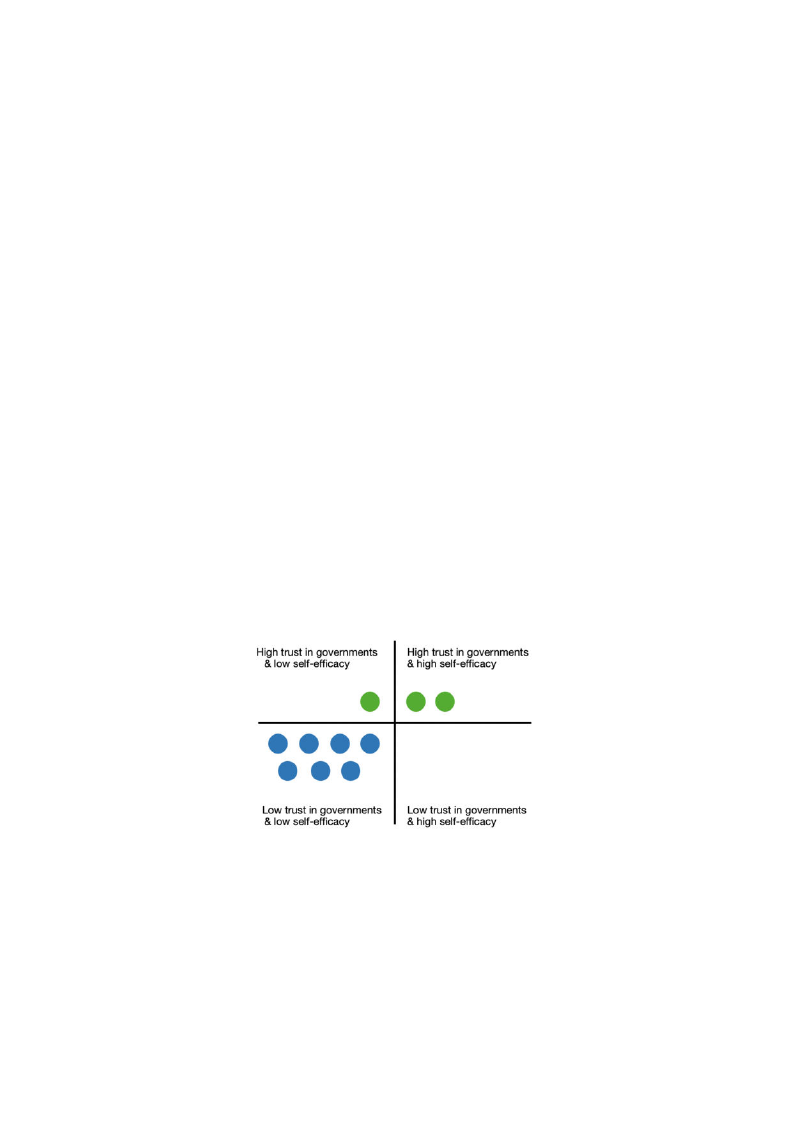
the research team concluded that the communities from Ukraine have a weak linking network, while
Germany has a strong linking network. The linking network refers to explicit ÔverticalÕ power
differences. As the SC model describes, a lack of linking network supports a higher level of mistrust
and low level of engagement between residents and governments. It is therefore reasonable to conclude
that the German communities would have less difficulties participating in a movement which can more
easily influence on a macro level, having in mind that their actions for change are not insignificant.
Lastly, focusing on the relationship between the individual and societal influence on local GRIs
(Research Question 1.1), the analysis brought forth multiple arguments, which will be discussed and
visualised in a diagram, the ÔHorizon of trustÕ, which was developed by the team of researchers.
Therefore, the final part of the discussion will ultimately venture to allow the authors of the thesis to
interpret the findings. In particular, the diagram strongly reflects the analytical results from the
discovered themes, such as ÔtrustÕ and self-efficacyÕ.
On the individual level the findings have been striking, Germans have a high self-efficacy level
while Ukrainians have a low-self efficacy level. As Ukrainian interviewees, who engage in surfing
communities, but do not belong to any GRI, yet, explain, that their perception of their actions is solely
inward. Their self-efficacy as activists is low, and usually do not even consider themselves activists,
even though it has got a high significance in their private and familiesÕ lives, where they lead by example
and with strong emotions. These urges to act are not yet, directed in a manner of forming a social
movement, because Ukrainian interviewees, representing the surfing communities, mention that they
have little trust in the government to support activism. They mention in the interviews that they do not
believe that they can have an impact, when the government does not foster it. Therefore, they do form
surfing communities, without considering these as GRIs, because fundamentally, they do not believe
bigger scale changes are about to take place.
As visualised in the units of the ÔHorizon of trustÕ which is divided into four segments: ÔHigh
trust in governments & low self-efficacyÕ, ÔHigh trust in governments & high self-efficacyÕ, ÔLow trust
in governments & low self-efficacyÕ and ÔLow trust in governments & high self-efficacyÕ. Each
interviewed surfer and activist will be displayed by an icon, indicating the country of residence.
Therefore, the distinction will be made between Ukrainians (blue icons) and Germans (green icons).
Figure 4. Horizon of trust (own diagram).
The total sum of Ukrainian interviewees is placed in ÔLow trust in government & self-efficacyÕ.
Although, Udovyk (2016) studied the effect of the Euromaidan Movement in Ukraine, which had shown
the successful formation of GRI movements and in 2013 to 2014 even led to a change of governmental
structures. Nevertheless, these protests were concerned with the resignation of Ukraine from the
Association Agreement with the EU, which was hoped to stabilize political and economic relations with
EU member states, secure equal rights for workers and build a step towards visa-free travelling of
Ukrainians (Yekelchyk, 2015). Therefore, these protests resulted from an immediate threat to all
31

Ukrainians. The researched niche of surfers, the threat of environmental changes and the pollution of
natural environments appear to be not as threatening as the right for democracy, a functioning political
system and a stable economic system. However, the interviewed surfers show great awareness for
environmental protection and a strong intrinsic development towards a conscious lifestyle. Yet, a
retention towards a more active behaviour, to the degree of being an ÔactivistÕ is present. The civil
conflict in 2013 to 2014 was highly intense and present. Thus, the level of urgency towards
environmentalism in recent times remains shallow. With this argument, the authors of the thesis assume
that there is potential for Ukrainians to achieve a higher self-efficacy level, despite not having support
from the government. This can be reached by external influences enhancing the process of making the
communities understand that global warming, environmental degradation and biodiversity loss is a
priority and can even threat their basic needs, which the participants of the research noticeably
mentioned and proved to consider relevant. As the recent European Parliament Elections have shown,
the awareness and discussion about climate change is as present as never before, thus, the balancing act
of environmental, economic and industrial interests remains a delicate issue (ÒEuropean ElectionÓ, May
24, 2019).
Therefore, the authors conclude, that a European wide awareness was raised and question
whether this attention was spread in Ukraine, too, as a country whose citizen hope to join the EU
(Euromaidan protests 2013-2014) or at least strengthen the European bonds. Nevertheless, it is
acknowledged that especially the most vigorous industries in Ukraine, such as cast iron and steel,
employ and influence a considerable number of Ukrainians. As outlined by Yekelchyk (2015) these
ÔdirtyÕ industries do not show a trend towards climate-friendlier alternatives. This being the case, the
authors see an intense conflict and correlation between the individual and societal level. While
arguments for the influence of each level are present, no distinct conclusion will be made which one
outweighs the other, since it is highly contextual and correlational.
Interestingly the German interviewees are positioned in ÔHigh trust in governments & low self-
efficacyÕ and ÔHigh trust in governments & high self-efficacyÕ. The influences that bring about
sustainable development and environmental activism through active and connected surfing grassroots
movements in EU countries such as Germany (Research Question 1.2), are discussed in the following
paragraph. First, as was mentioned in Ô1.2.2. Germany: The country, their environmental attitude and
surfing movementsÕ, GermanyÕs political parties and citizens show more recognition for the planetÕs
scarce resources and the need for environmental protection in comparison with other countries.
Moreover, the interviewed German surfers mentioned that they felt safe and supported by their country
even in times of uncertainty. This political support was seen as a highly important component for
communities to start forming GRIs. Secondly, Grabs (2015) explains that media is crucial for providing
information and creating awareness, which can result in the formation of GRIs. Germans supported this
statement, as they started being aware of environmental damages due to the information they read in
newspapers or other sources. Finally, a great example was provided by the insular community, which
was described by German Interviewee 3. A great standard of social cohesion was present; thus, the level
of trust was high. Therefore, the preconditions for the formation of an activistic network are realistically
attainable. Thereby, the local surfing club and surrounded community present ideal circumstances for
beginning in this particular (surfing) community in Germany. Nevertheless, the term ÔbeginningÕ is
used, since the mentioned interviewee did not reveal a high level of self-efficacy, yet. Moreover, the
co-founders of the local chapter of the IOSF (German Interviewee 1; 2) agree, that Germany is an ideal
place for GRI formation.
Still, the authors of the thesis acknowledge the unanimity of the interviewed surfers and
question which influences could potentially undermine these conclusions. Regional influences, such as
the level of socio-economic factors, could affect these statements. Moreover, the high literacy rate of
32

Germans was universally concluded by interviewees, whilst it must be deliberated upon the section of
the population to whom this might not be applicable to. Likewise, German citizen that struggle with
housing, job seeking, family issues and professional development might not be the ideal context for the
formation of GRIs. Even though in this particular context, German interviewees mentioned their times
of uncertainty as a Ôfree spaceÕ for activism. Therefore, individual contexts need to be considered.
Whilst the Ukrainian context shows that the industries (cast iron & steel) were considered as strong
influences on the environmental awareness of Ukrainians, it is important to mention, that parts of
Germany are also operating in the industrial sectors, even though the German industries appear to align
their visions in a ÔgreenerÕ direction. Nevertheless, the observed context revealed ideal preconditions
and supportive influences around the formation of GRIs in surfing communities.
6.1 Future Research
Finally, areas for further research are identified by the authors of the thesis, who suggest future
research to include the mentioned theoretical field of ecopsychology. In particular, the field of
ecopsychology and the human-nature interconnections could be expanded in further research when
focusing on GRIs through active and connected surfing communities towards environmental activism
and sustainable development. According to the analysis of the paper, two German interviewees mention
that they prioritize the activism in their lives over other aspects. Ukrainian Interviewees have not
mentioned these tendencies at all. Therefore, further and more specific research in the field of activism
on an individual level should be considered. Further focus on leadership involvement of activist in the
forming of GRIs in surfing communities would be relevant for the field. As well as the concept of self-
efficacy of environmental activists can be studied thoroughly towards the questions on leadership
influence the self-efficacy in the group of environmental activists.
7. Conclusion
The aim of the thesis was to explore the potential of local surfing communities to transform
into GRIs and act as sustainable leaders to bring change towards sustainable development and
environmental activism. The research aimed to identify relevant influences to foster this progress.
Concluding the research findings from the collected data analysis, strong distinctions arise.
Firstly, the economic stability in Germany and Ukraine displays fundamental differences (Yekelchyk,
2015; Magnani & Osti, 2016). As the previous research by Magnani and Osti (2016) described, Western
and Northern Europe have higher incomes and more stable economies than Southern and Eastern
Europe. In addition to it, Eastern Ukraine faces a war and great capacities from the government's focus
and household budget upholds the country. Consequently, the unstable political situation and fight for
democracy, as mentioned by interviewees the fight for Ôbasic needsÕ, is prioritized over the formation
of GRIs. Moreover, the collected data revealed a high degree of mistrust towards the government, as
Ukrainians are exposed to corruption in their private and professional lives. This highlights the different
stage that Ukraine is in. Meanwhile, Germany has more economical resources than Ukraine to utilize
for the formation of social movements (Magnani & Osti, 2016). As agreed by the German interviewees,
they see Germany as an ideal place for the formation of GRIs and entity as activists and describe a high
level of self-efficacy and trust towards their government.
Generally, the research concludes that the popularity of surfing increases. Therefore, it is an
interesting social movement and niche to observe. Moreover, the closeness of humans and nature,
especially when engaging in surfing was detected as a strong given connection. This is relevant due to
the fact, that humans who feel a strong connection to the natural environment also feel a stronger urge
33

to protect it. Therefore, surfing communities bear a great potential for the GRI formation and
environmental activism. Lastly, the analysis and discussion clarified, that the high trust in governments
and high self-efficacy are preconditions for the formation of GRIs in surfing communities. Countries
with high trust in governments and high self-efficacy levels appear as the ideal context for GRI in
surfing communities.
34

References
A European Network of Volunteers (2019). Surfrider Foundation Europe. Retrieved from
https://www.surfrider.eu/en/organization
Alvesson, M. (2011). Interpreting interviews. SAGE. Retrieved from
https://search.ebscohost.com/login.aspx?direct=true&db=cat05074a&AN=malmo.b1829259&site=ed
s-live
ÒAnnual Report #17Ó (2017). Surfrider Foundation. Retrieved from https://surfrider.eu/wp-
content/uploads/2014/12/rapportannuel2017_en_v1_web.pdf
Arnold, H. E., Cohen, F. G., & Warner, A. (2009). Youth and environmental action:
Perspectives of young environmental leaders on their formative influences. The Journal of
environmental education, 40(3), 27-36. Retrieved from https://doi-
org.proxy.mau.se/10.3200/JOEE.40.3.27-36
Assenjo, G. & Sico, R. (2017). Surfrider Foundation Europe. Annual Report 2017. Retrieved
from https://s3-us-west-2.amazonaws.com/publicfiles.surfrider.org/Surfrider-Foundation-2017-Ann
ual-Report.pdf
Perri & Bellamy, C. (2012). Principles of Methodology. Research design in social science.
Sage Publications Inc. Retrieved from https://journals-sagepub-
com.proxy.mau.se/doi/full/10.1177/1350507614550754
Baker, J. (2013). What have we done to Mother Earth? Psychodynamic thinking applied to
our current world crisis. Psychodynamic Practice, 19(1), 55-67. Retrieved from
https://www.tandfonline.com/doi/full/10.1080/14753634.2013.748552
Bandura, A. (1977). Social learning theory. Prentice Hall. Retrieved from
https://search.ebscohost.com/login.aspx?direct=true&db=cat05074a&AN=malmo.b2353801&site=ed
s-live
Bandura, A. (1989). Human agency in social cognitive theory. American psychologist, 44(9),
1175. Retrieved from
https://search.ebscohost.com/login.aspx?direct=true&db=edsovi&AN=edsovi.00000487.198909000.0
0001&site=eds-live
Bandura, A. (2001). Social Cognitive Theory: An Agentic Perspective. Annual Review of
Psychology, 1. Retrieved from
https://search.ebscohost.com/login.aspx?direct=true&db=edsovi&AN=edsovi.00000689.200100000.0
0004&site=eds-live
Brymer, E., Downey, G., & Gray, T. (2009). Extreme Sports as a Precursor to Environmental
Sustainability. Journal of Sport & Tourism, 14(2/3), 193Ð204. Retrieved from https://search-
ebscohost-com.proxy.mau.se/login.aspx?direct=true&db=s3h&AN=42746513&site=eds-live
35

Brymer, E., & Gray, T. (2009). Dancing with nature: Rhythm and harmony in extreme sport
participation. Journal of Adventure Education & Outdoor Learning, 9(2), 135-149. Retrieved from
https://www.tandfonline.com/doi/full/10.1080/14729670903116912
Campbell, J.L., & Hammersley, M. (2012). What is qualitative Research? Bloomsbury
Academic. Retrieved from https://www.bloomsburycollections.com/book/what-is-qualitative-
research/ch1-defining-qualitative-
researchhttps://search.ebscohost.com/login.aspx?direct=true&db=cat05074a&AN=malmo.b1883350
&site=eds-live
Climate change in the context of Paris Agreement commitments: challenges and cooperation
opportunities for the EU and Ukraine. Report. (2018). Retrieved from https://eap-csf.eu/reporting-
2018/?lang=ru
Chawla, L. (1999). Life paths into effective environmental action. The Journal of
Environmental Education, 31(1), 15-26. Retrieved from
https://www.colorado.edu/cedar/sites/default/files/attached-
files/Chawla,%20L%20(1999).%20Lifepaths%20into%20effective%20environmental%20action.%20
Journal%20of%20Environmental%20Education,%2031(1),%2015-26..pdf
Chawla, L. (1998). Significant life experiences revisited: A review of research on sources of
environmental sensitivity. The Journal of environmental education, 29(3), 11-21. Retrieved from
https://www.tandfonline.com/doi/pdf/10.1080/1350462980040402?needAccess=true
Chawla, L. (2007). Childhood experiences associated with care for the natural world: A
theoretical framework for empirical results. Children Youth and Environments, 17(4), 144-170
Retrieved from
https://www.jstor.org/stable/pdf/10.7721/chilyoutenvi.17.4.0144.pdf?refreqid=excelsior%3A4cbc3c0
b6b493cbf7ce9b1a0b0b1577d
Chazdon, S. A., & Lott, S. (2010.). Ready for engagement: Using key informant interviews to
measure community social capacity. Community Development, 41(2), 156Ð175. Retrieved from
https://doi-org.proxy.mau.se/10.1080/15575331003646173
Edwards, B. (2013). Social Capital and Social Movements. Blackwell Publishing Ltd.
Retrieved from https://onlinelibrary.wiley.com/doi/abs/10.1002/9780470674871.wbespm187
European elections: Ocean Friendly or not? (24.05.2019) Retrieved from
https://surfrider.eu/en/learn/news/elections-europeennes-ocean-121524191274.html
Feola, G., & Nunes, R. (2014). Success and failure of grassroots innovations for addressing
climate change: The case of the Transition Movement. Global Environmental Change, 24, 232Ð250.
Retrieved from https://doi-org.proxy.mau.se/10.1016/j.gloenvcha.2013.11.011
Flick, U. (2018). The Sage handbook of qualitative data collection. SAGE Publications Ltd.
Retrieved from https://search-ebscohost-
com.proxy.mau.se/login.aspx?direct=true&db=cat05074a&AN=malmo.b2231178&site=eds-live
36

Flora, J. L., & Fey, S. (2004). Rural communities: Legacy and change. Thousand Oaks, CA:
Sage Publications. Retrieved from https://doi.org/10.4324/9780429494697
First surfing championship in Odessa (2018). Retrieved from
https://ru.tsn.ua/ukrayina/v-odesse-vpervye-v-ukraine-proshli-sorevnovaniya-po-serfingu-
1223058.html
Gage, M., & Polatajko, H. (1994). Enhancing Occupational Performance Through an
Understanding of Perceived Self-Efficacy. The American Journal of Occupational Therapy, 48(5),
452-460. Retrieved from https://psycnet.apa.org/record/1994-42883-001
Gibson, E. J., & Pick, A. D. (2000). An ecological approach to perceptual learning and
development. Oxford University Press, USA. Retrieved from
https://web.a.ebscohost.com/ehost/ebookviewer/ebook/bmxlYmtfXzI3NzY1OF9fQU41?sid=c0303f0
3-dd90-4d5b-89db-bc0adf0cc281@sdc-v-sessmgr06&vid=0&format=EB&rid=1
Gibson, E. J. (1969). Principles of perceptual learning and development. Retrieved from
https://psycnet.apa.org/record/1969-35014-000
Gough, A., Birdsall, S., White, P., & Cutter-Mackenzie, A. (2017). Social Learning Towards
a Sustainable World: Principles, Perspectives and Praxis. Australian Journal of Environmental
Education, 33(3), 234Ð237. Retrieved from https://doi.org/10.1017/aee.2017.20
Golafshani, N. (2003). Understanding reliability and validity in qualitative research. The
qualitative report, 8(4), 597-606. Retrieved from
https://nsuworks.nova.edu/tqr/vol8/iss4/6/?&sa=U&ei=ysMjVIynMZHd7Qay44H4DQ&ved=0CEEQ
FjAI&usg=AFQjCNFpuZ6PjJRw2DDeLP5vBVIRU5O79A/
Grabs, J., Langen, N., Maschkowski, G., & SchŠpke, N. (2016). Review: Understanding role
models for change: a multilevel analysis of success factors of grassroots initiatives for sustainable
consumption. Journal of Cleaner Production, 134, 98Ð111. Retrieved from https://doi-
org.proxy.mau.se/10.1016/j.jclepro.2015.10.061
Grin, J., Rotmans, J., & Schot, J. (2010). Transitions to sustainable development: new
directions in the study of long term transformative change. Routledge. Retrieved from https://doi-
org.proxy.mau.se/10.1080/09644016.2012.724243
Grusec, J. E. (1992). Social Learning Theory and Developmental Psychology: The Legacies
of Robert Sears and Albert Bandura. Developmental Psychology, 28(5), 776Ð86. Retrieved from
https://search.ebscohost.com/login.aspx?direct=true&db=eric&AN=EJ453420&site=eds-live
Guerr—n-Montero, C. (2005). Marine Protected Areas in Panama: Grassroots Activism and
Advocacy. Human Organization, 64(4), 360. Retrieved from https://search-ebscohost-
com.proxy.mau.se/login.aspx?direct=true&db=edsjsr&AN=edsjsr.44127367&site=eds-live
37

Heaton, J. (2004). Reworking qualitative data. SAGE. Retrieved from
https://search.ebscohost.com/login.aspx?direct=true&db=cat05074a&AN=malmo.b1829505&site=ed
s-live
Heft, H. (1988). Affordances of children's environments: A functional approach to
environmental description. Children's Environments Quarterly, 29-37. Retrieved from https://search-
ebscohost-com.proxy.mau.se/login.aspx?direct=true&db=edsjsr&AN=edsjsr.41514683&site=eds-live
Hibbard, W. (2003). Ecopsychology: A review. Trumpeter, 19(2). Retrieved from
http://trumpeter.athabascau.ca/index.php/trumpet/article/viewFile/93/96
Hi, itÕs us! (2019). SurfinÕUA. Retrieved from https://www.surfinua.com/
Ideas for Actions (2019). EWWR Website. Retrieved from
http://www.ewwr.eu/en/ideas/ideas-for-actions
Kemp, R., Schot, J., & Hoogma, R. (1998). Regime shifts to sustainability through processes
of niche formation: The approach of strategic niche management. Technology Analysis and Strategic
Management, 10(2), 175Ð195. Retrieved from https://search-ebscohost-
com.proxy.mau.se/login.aspx?direct=true&db=edselc&AN=edselc.2-52.0-0001513530&site=eds-live
Kenrick, D. T., Griskevicius, V., Neuberg, S. L., & Schaller, M. (2010). Renovating the
Pyramid of Needs: Contemporary Extensions Built Upon Ancient Foundations. Perspectives on
psychological science, 5(3), 292Ð314.Retrieved from https://doi-
org.proxy.mau.se/10.1177/1745691610369469
Kern, K. (2019). Cities as leaders in EU multilevel climate governance: embedded upscaling
of local experiments in Europe. Environmental Politics, 28(1), 125Ð145. Retrieved from
https://doi.org/10.1080/09644016.2019.1521979
Klein, D., Carazo, M. P., Doelle, M., Bulmer, J., & Higham, A. (2017). The Paris Climate
Agreement : Analysis and Commentary. Oxford University Press. Retrieved from
https://search.ebscohost.com/login.aspx?direct=true&db=cat05074a&AN=malmo.b2281445&lang=sv
&site=eds-live
Kinder, D. 1994. Why psychology is mute about the environmental crisis. Environmental
Ethics 16: 359-376. Retrieved from
https://www.pdcnet.org/enviroethics/content/enviroethics_1994_0016_0004_0359_0376
Knill, C., Heichel, S., & Arndt, D. (2012). Really a front-runner, really a Straggler? Of
environmental leaders and laggards in the European Union and beyond - A quantitative policy
perspective. Energy Policy. Retrieved from https://doi-org.proxy.mau.se/10.1016/j.enpol.2012.04.043
Kj¿lsr¿d, L. (2013). Mediated Activism: Contingent Democracy in Leisure Worlds.
Sociology, 47(6), 1207. Retrieved from https://search-ebscohost-
com.proxy.mau.se/login.aspx?direct=true&db=edsjsr&AN=edsjsr.24433694&site=eds-live
38

KyttŠ, M. (2004). The extent of children's independent mobility and the number of actualized
affordances as criteria for child-friendly environments. Journal of environmental psychology, 24(2),
179-198. Retrieved from https://www.sciencedirect.com/science/article/abs/pii/S0272494403000732
Laviolette, P. (2006). Green and Extreme: Free-Flowing through Seascape and Sewer.
Worldviews, 10(2), 178. Retrieved from https://search-ebscohost-
com.proxy.mau.se/login.aspx?direct=true&db=edsjsr&AN=edsjsr.43809684&site=eds-live
Lieblich, A., Tuval-Mashiach, R., & Zilber, T. B. (1998). Narrative research: reading,
analysis and interpretation. SAGE. Retrieved from
https://search.ebscohost.com/login.aspx?direct=true&db=cat05074a&AN=malmo.b1829375&site=ed
s-live
Magnani, N., & Osti, G. (2016). Does civil society matter? Challenges and strategies of
grassroots initiatives in ItalyÕs energy transition. Energy Research & Social Science, 13, 148Ð157.
Retrieved from: https://doi-org.proxy.mau.se/10.1016/j.erss.2015.12.012
Mihaylov, N.L., & Perkins, D.D. (2015). Local Environmental Grassroots Activism:
Contributions from Environmental Psychology, Sociology and Politics. Behavioral Sciences, (1), 121.
Retrieved from https://doi-org.proxy.mau.se/10.3390/bs5010121
Olsen, M. (2001). Women who risk: Profiles of women in extreme sports. Hatherleigh Press.
Ornetzeder, M., & Rohracher, H. (2013). Of solar collectors, wind power, and car sharing:
Comparing and understanding successful cases of grassroots innovations. Global Environmental
Change-Human and policy dimensions, 23(5), 856Ð867. Retrieved from https://doi-
org.proxy.mau.se/10.1016/j.gloenvcha.2012.12.007
Our oceans, waves, and beaches are everything. LetÕs save them. (2019). Surfrider
Foundation US. Retrieved from https://www.surfrider.org/about
Paldam, M. (2000). Social Capital: One or Many? Definition and Measurement. Journal of
Economic Surveys, 14(5), 629. Retrieved from
https://search.ebscohost.com/login.aspx?direct=true&db=edb&AN=4889881&site=eds-live
Parris, D. L., Shapiro, S. L., Welty Peachey, J., Bowers, J. , & Bouchet, A. (2015). More than
competition: exploring stakeholder identities at a grassroots cause-related sporting event.
International Review on Public and Nonprofit Marketing, 12(2), 115Ð140. Retrieved from: https://doi-
org.proxy.mau.se/10.1007/s12208-015-0129-4
Pearlmutter, S. (1998). Self-Efficacy and Organizational Change Leadership. Administration
in Social Work, 22(3), 23-38. Retrieved from
https://www.tandfonline.com/doi/abs/10.1300/J147v22n03_02
Raworth, K., Sweetman, C., Narayan, S., Rowlands, J., & Hopkins, A. (2012). Conducting
semi-structured interviews. Oxfam. Retrieved from: https://books.google.se/books?id=-
39

dHtAQAAQBAJ&printsec=frontcover&hl=nl&source=gbs_ge_summary_r&cad=0#v=onepage&q&f
=false
Reed, E. S. (1996). Encountering the world: Toward an ecological psychology. Oxford
University Press. Retrieved from https://doi-
org.proxy.mau.se/10.1093/acprof:oso/9780195073010.001.0001
Reed, M., Evely, A.C., Cundill, G., Fazey, I.R.A., Glass, J., Laing, A., Newig, J., Parrish, B.,
Prell, C., Raymond, C., & Stringer, L. (2010). What is Social Learning? Ecology and Society, 15(4).
Retrieved from
https://search.ebscohost.com/login.aspx?direct=true&db=edsjsr&AN=edsjsr.26268235&site=eds-live
Ritchie, J., Lewis, J., Mcnaughton Nickels, C., & Ormston, R. (2014). Qualitative Research
Practice. SAGE. Retrieved from
https://books.google.se/books?hl=de&lr=&id=EQSIAwAAQBAJ&oi=fnd&pg=PA1&dq=qualitative+
research+stresses+the+socially+constructed+nature+of+reality&ots=l_UQnxXz3P&sig=nVuLGROd
ou6Dwl_kLLtXRdc0-BM&redir_esc=y#v=onepage&q=histories&f=false
Rodwell , M. K. (1998). Social Work Constructivist Research. Routledge; 1 edition (July 3,
1998). Retrieved from https://search-ebscohost-
com.proxy.mau.se/login.aspx?direct=true&db=ehh&AN=15786965&site=eds-live
Roszak, T. E., Gomes, M. E., & Kanner, A. D. (1995). Ecopsychology: Restoring the earth,
healing the mind. Sierra Club Books. Retrieved from https://psycnet.apa.org/record/1995-97862-000
Saunders, M., Lewis, P. & Thornhill, A. (2012) ÒResearch Methods for Business StudentsÓ.
Pearson Education Limited. Retrieved from
https://www.researchgate.net/profile/Mark_Saunders4/publication/330760964_Research_Methods_fo
r_Business_Students_Chapter_4_Understanding_research_philosophy_and_approaches_to_theory_de
velopment/links/5c53056f299bf12be3f0e2cf/Research-Methods-for-Business-Students-Chapter-4-
Understanding-research-philosophy-and-approaches-to-theory-development.pdf
Schreurs, M. A. (2016). Is Germany Really an Environmental Leader? CURRENT
HISTORY, 115(779), 114Ð116. Retrieved from https://search-ebscohost-
com.proxy.mau.se/login.aspx?direct=true&db=edswss&AN=000370834300006&site=eds-live
Scull, J. (2008). Ecopsychology: Where does it fit in psychology in 2009?. Trumpeter, 24(3).
Retrieved from http://trumpeter.athabascau.ca/index.php/trumpet/article/viewFile/1100/1429
Seyfang, G., & Smith, A. (2007). Grassroots innovations for sustainable development:
Towards a new research and policy agenda. Environmental politics, 16(4), 584-603. Retrieved from
https://www-tandfonline-com.proxy.mau.se/doi/full/10.1080/09644010701419121
Seyfang, G., & Haxeltine, A. (2012). Growing grassroots innovations: exploring the role of
community-based initiatives in governing sustainable energy transitions. Environment and planning
c-government and policy, 30(3), 381Ð400. Retrieved from https://doi-
org.proxy.mau.se/10.1068/c10222
40

SiisiŠinen, M. (2000). Two Concepts of Social Capital: Bourdieu vs Putnam. Department of
Social Sciences and Philosophy. Retrieved from
http://dlc.dlib.indiana.edu/dlc/bitstream/handle/10535/7661/siisiainen.pdf
Simeonova, A., & Chuturkova, R. (2019). Marine litter accumulation along the Bulgarian
Black Sea coast: Categories and predominance. Waste Management, 84, 182-193. Retrieved from
https://doi.org/10.1016/j.marpolbul.2017.03.035
Sivek, D. J. (2002). Environmental sensitivity among Wisconsin high school students.
Environmental Education Research, 8(2), 155-170. Retrieved from https://doi-
org.proxy.mau.se/10.1080/13504620220128220
Surfing in Odessa: On the crest of a Black Sea wave (2016). Retrieved from
http://odessa.net.ua/news/serfing-v-odesse-na-grebne-chernomorskoj-volny
Turchenko, O., Viriovkina, L., Tselocalchenko, N., Zakrevska, S., & Bondarenko, S. (2017).
Report of the UA CSP: Public policy of Ukraine on internally displaced persons in the context of
implementation of the Association agreement. Civil Society Platform. Retrieved from:
https://www.eesc.europa.eu/en/documents/report-ua-csp-public-policy-ukraine-internally-displaced-
persons-context-implementation-association-agreement
Udovyk, O. (2017). Beyond the Conflict and Weak Civil Society; Stories from Ukraine: Cases
of Grassroots Initiatives for Sustainable Development. East/West: Journal of Ukrainian Studies, 4(2),
187-210. Retrieved from: https://doi.org/10.21226/T27W6R
Udovyk, O. (2016). ÔI cannot be passive as I was beforeÕ: learning from grassroots
innovations in Ukraine. European journal for Research on the Education and Learning of Adults, 8(2),
225-243. Retrieved from: https://doi.org/10.3384/rela.2000-7426.rela9090
Uhlik, K. S. (2006). The ÒnatureÓ of leadership philosophy in outdoor and adventure
education: Partnership or predation. Journal of Adventure Education & Outdoor Learning, 6(2), 135-
142. Retrieved from
https://www.tandfonline.com/doi/abs/10.1080/14729670685200811?casa_token=3WmUNVOXWYg
AAAAA:3TApX2L6SKjG8gZHu6NlQl7u1ltIeENgL6Gh0YlkFpAzjaorx5g21QKQtKwINNJ8hm-
Z9PSsnZH8
Our common future: report of the world commission on Environment and Development.
United Nations documents. Retrieved from https://www.are.admin.ch/are/en/home/sustainable-
development/international-cooperation/2030agenda/un-_-milestones-in-sustainable-
development/1987--brundtland-report.html
Wheaton, B. (2007). Identity, Politics, and the Beach: Environmental Activism in Surfers
Against Sewage. Leisure Studies, 26(3), 279Ð302. Retrieved from
https://doi.org/10.1080/02614360601053533
41

Winter, D. (1996). Ecological psychology: Healing the split between planet and self. New
York: Harper Collins. Retrieved from: https://doi.org/10.1207/s15327949pac0503_9
Wiles, J. L., Rosenberg, M. W., & Kearns, R. A. (2005). Narrative analysis as a strategy for
understanding interview talk in geographic research. Area, 37(1), 89-99. Retrieved from:
https://search-ebscohost-
com.proxy.mau.se/login.aspx?direct=true&db=edsjsr&AN=edsjsr.20004433&site=eds-live
Wood, R., Bandura, A., & Bailey, T. (1990). Mechanisms governing organizational
performance in complex decision-making environments. Organizational behavior and human decision
processes, 46(2), 181-201. Retrieved from https://doi-org.proxy.mau.se/10.1016/0749-
5978(90)90028-8
Woolcock, M., & Narayan, D. (2000). Social Capital: Implications for Development Theory,
Research, and Policy. The World Bank Research Observer, 15(2), 225. Retrieved from https://search-
ebscohost-com.proxy.mau.se/login.aspx?direct=true&db=edsjsr&AN=edsjsr.3986417&site=eds-live
Yekelchyk, S. (2015). The Conflict in Ukraine : What Everyone Needs to Know? Oxford
University Press. Retrieved from
https://ebookcentral.proquest.com/lib/malmo/reader.action?docID=2121292&ppg=177
42

Appendix
1. Interview Questions
Table 2. Interview Questions for Ukrainians
No. Question
1 Do you surf?
2 When was the first time you surfed?
3 What do you love about surfing?
4 How would you describe the feeling to be in the water?
5 Do you feel connected to the ocean/nature while surfing?
6 Do you think that this is something you and other surfers share?
7 Have you always felt like protecting the environment?
8 Was there any particular event or a person that influenced changing the attitude to
the environment?
9 How do you define activism yourself?
10 Would you consider yourself an activist?
11 Do you struggle with housing, job seeking, family, professional development etc at
the moment?
12 Is there any political / law (policies, regulations) framework that supports the
activities of your organisation in your country?
13 Do you feel like your country is an ideal place for grassroots initiatives?
14 Do you know the political context in your country in terms of adaptation to climate
change?
15 How do you think the political situation in your country influences the work your
organisation is currently doing?
16 Do you know about IOSF? (explain the aim). Do you know any similar
organisations across the world or in Ukraine?
17 Do you think it is relevant to have such an initiative in Ukraine?
43

18 How USF can be useful in this and what are the problems and challenges you think
it can tackle?
19 Is there anything more you would like me to know / share with me?
20 Do you have any questions to the interviewer?
Table 3. Interview Questions for German IOSF-Characters
No. Question
1 Do you surf?
2 When was the first time you surfed?
3 What do you love about surfing?
4 How would you describe the feeling to be in the water?
5 Do you feel connected to nature while you surf?
6 Do you think that this is something you and other surfers share?
7 Is that something you talk about or is that something one keeps internally?
8 Have you always felt like protecting the environment?
9 Was there any particular event or a person that influenced changing the attitude to
the environment?
10 How do you define activism yourself?
11 Would you consider yourself an activist?
12 Is activism a priority of yours right now?
13 Do you struggle with housing, job seeking, family, professional development etc at the
moment?
14 So do you feel like you have capacities for activism right now?
15 How did you get in contact with IOSF?
16 Why this IOSF?
17 WhatÕs your role at IOSF in your country?
18 Can you describe the structure at IOSF?
19 How are the local chapters interconnected?
44

20 Do you have funding sources? Do you need funding and for what?
21 Do you try to involve new members to be active participants? Why/not?
22 Do the members/volunteers require any particular skills to be a part of the
movement?
23 If they are / how much time do you expect from them to be involved in the
activities?
24 How much time do you invest in IOSF?
25 Is the vision and mission of IOSF pre-defined by the IOSF-organization? Who
participates in the process? decision-making process?
26 Are there challenges the organisation is facing at the moment?
27 Have you heard about other surfing organizations that do similar actions?
28 Do you have more trust in your community/peers since you joined IOSF, because
you know there are many people who think just like you?
29 Do you cooperate with private businesses? How much support do you get from
them?
30 Do you cooperate with government agencies and to what extent? How much support
do you get for the activities of your organization?
31 How do you communicate the messages of the organisation to external
stakeholders?
32 Who is your target audience (who do you want to influence) and how do you
communicate with them? Do you hold any public activities or event to
communicate?
33 In what way does your organization want to change the behaviour of the target
audience?
34 Is there any political / law (policies, regulations) framework that supports the
activities of your organisation in your country?
35 Do you feel like your country is a good place for grassroots initiatives?
36 Do you know the political context in your country in terms of adaptation to climate
change?
37 How do you think the political situation in your country influences the work your
organisation is currently doing?
38 Is there anything about IOSF that you still want me to know?
39 Is there anything more you would like me to know / share with me?
45

40 Do you have any questions to the interviewer?
46
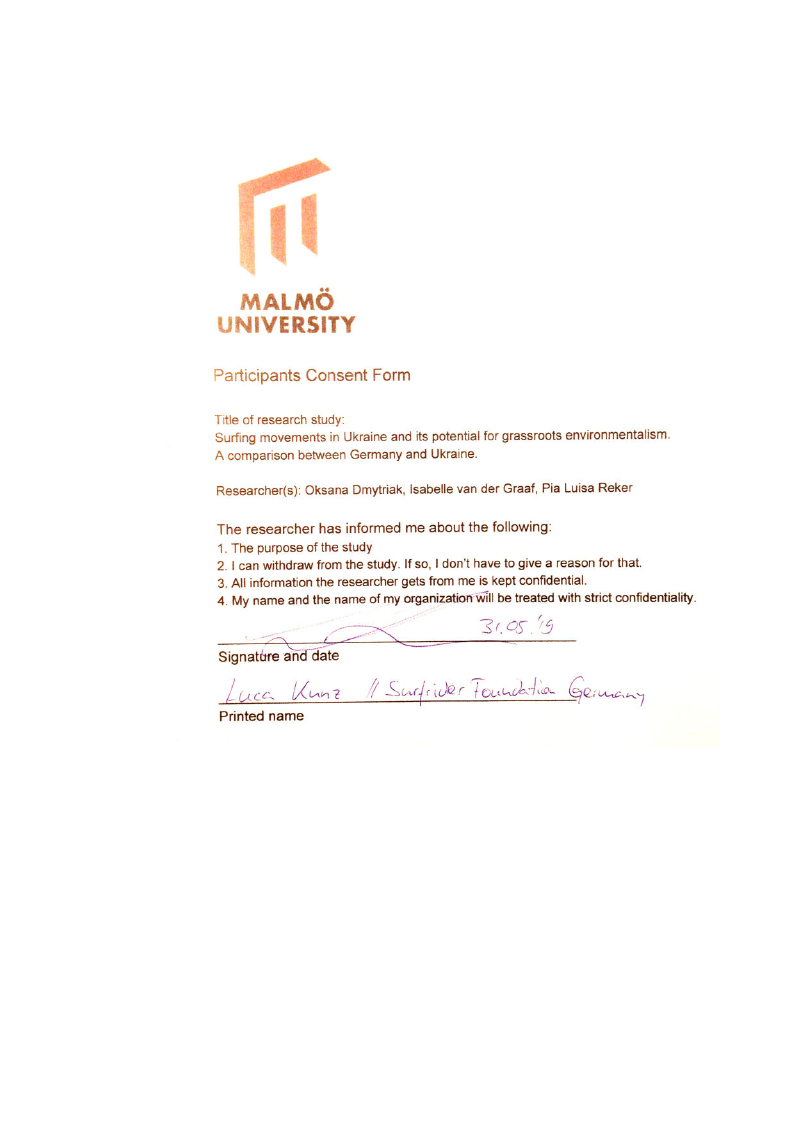
2. Consent Forms
47
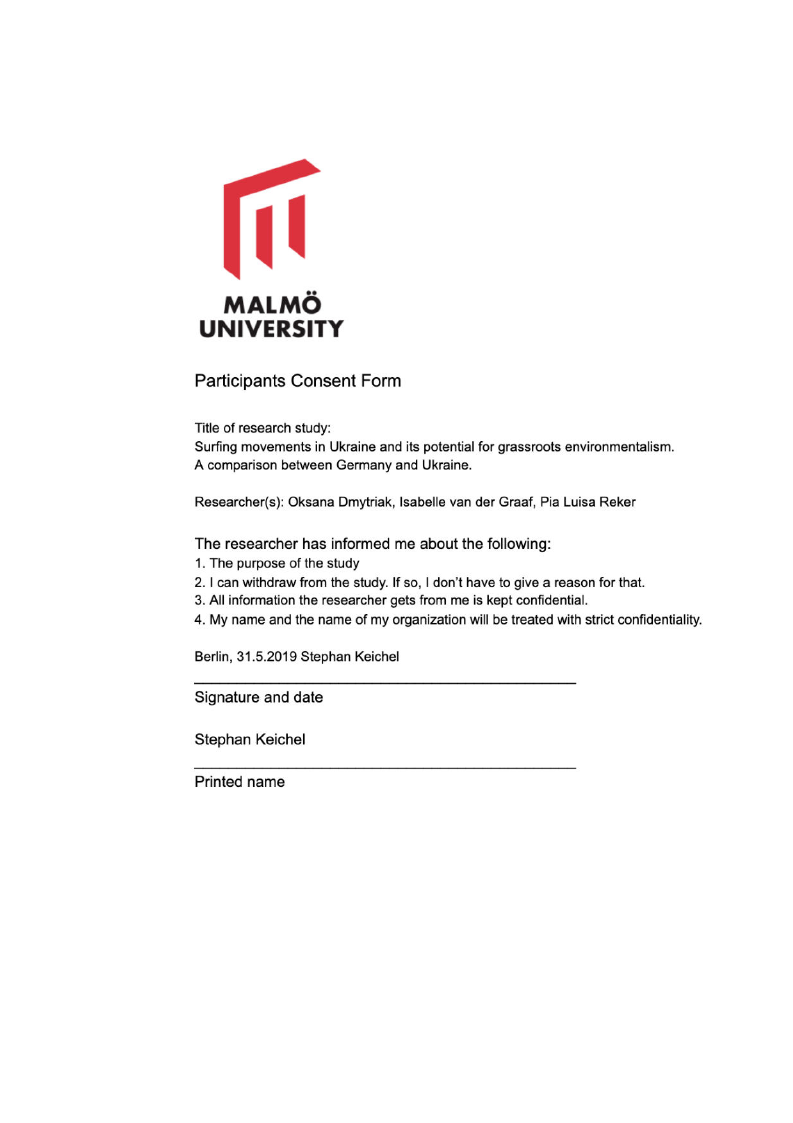
48
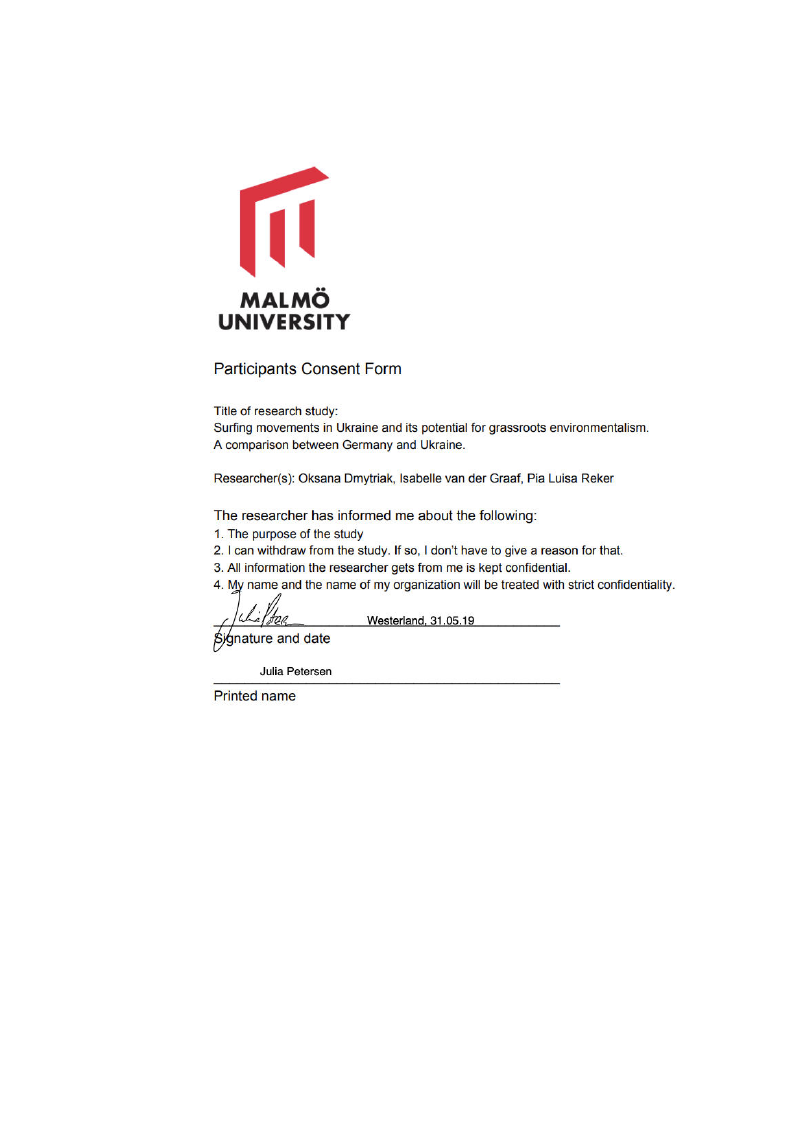
49
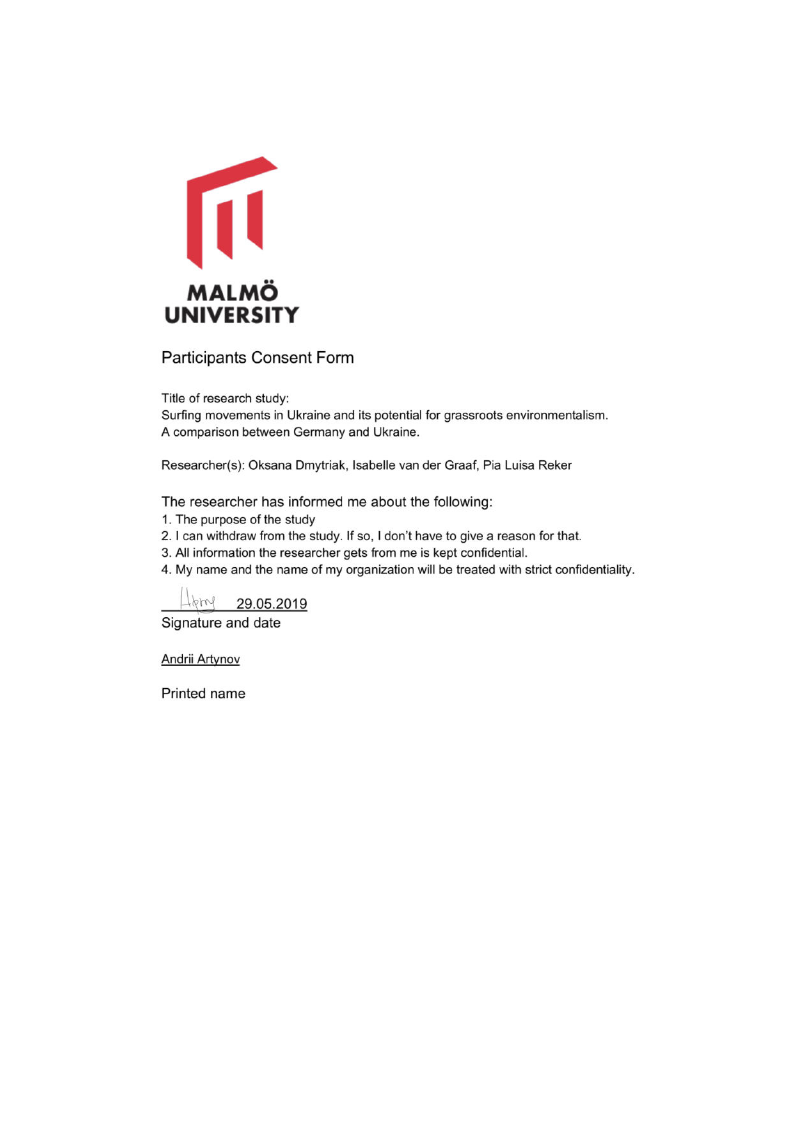
50
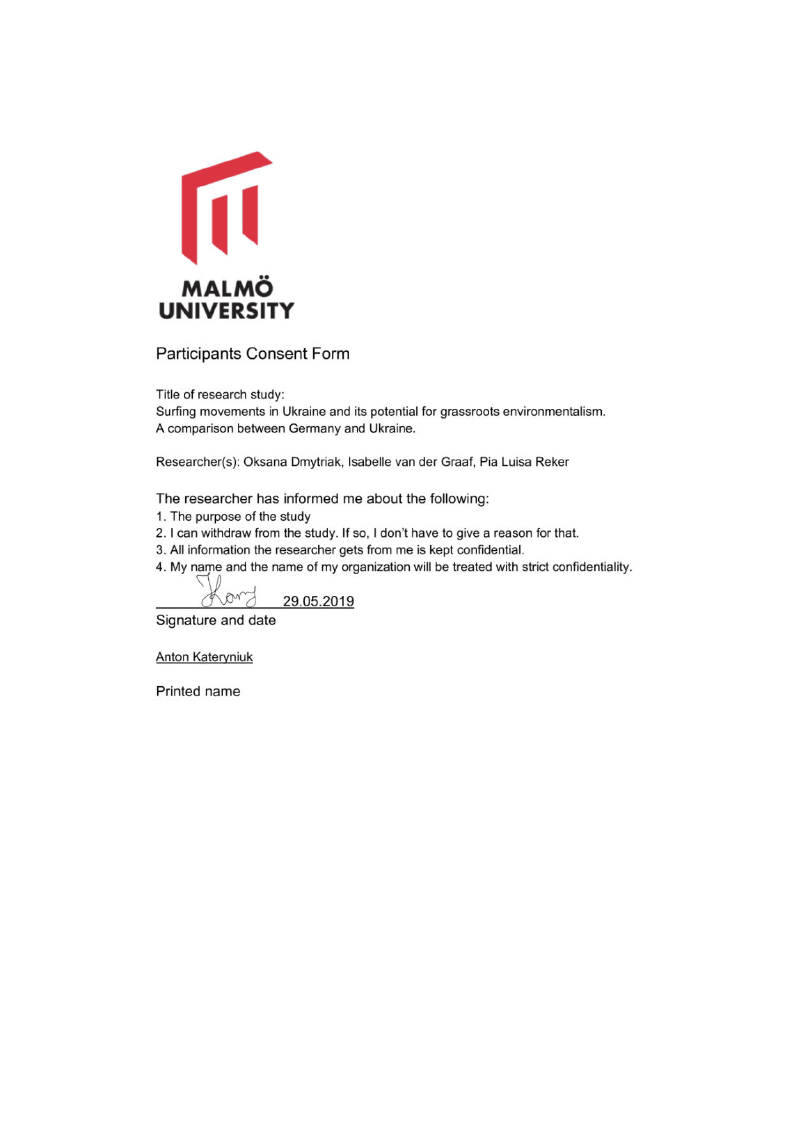
51
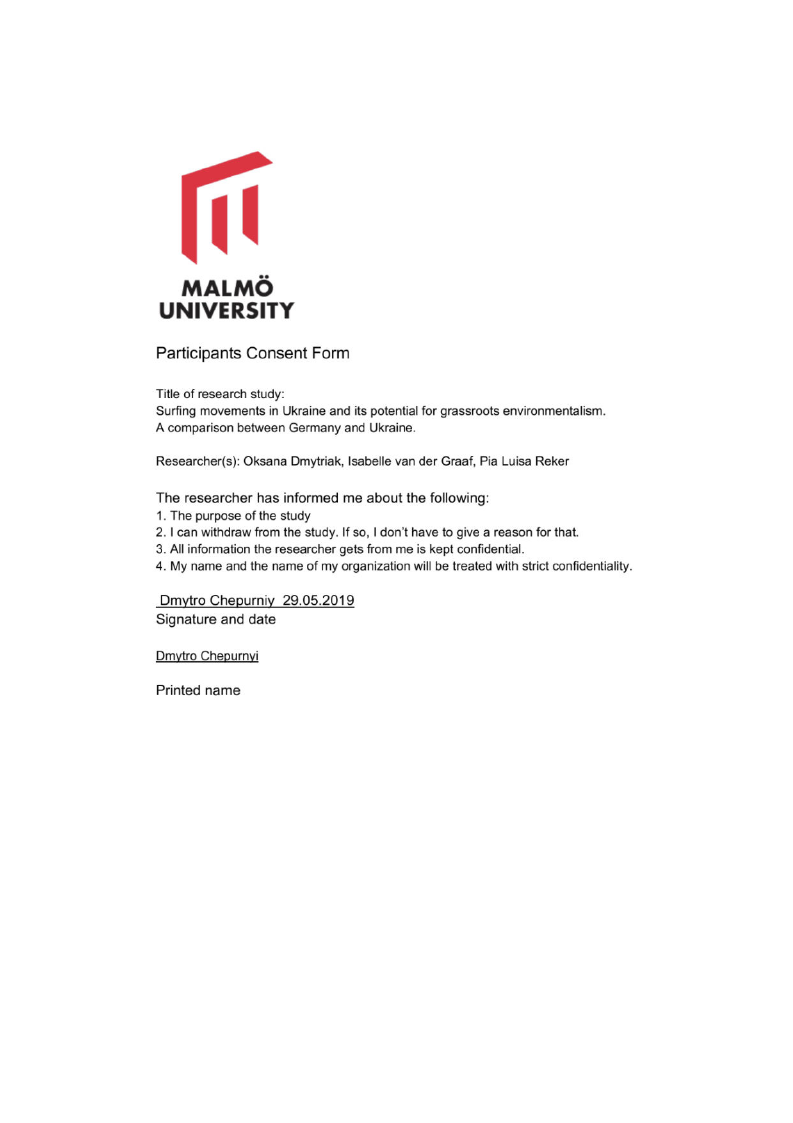
52
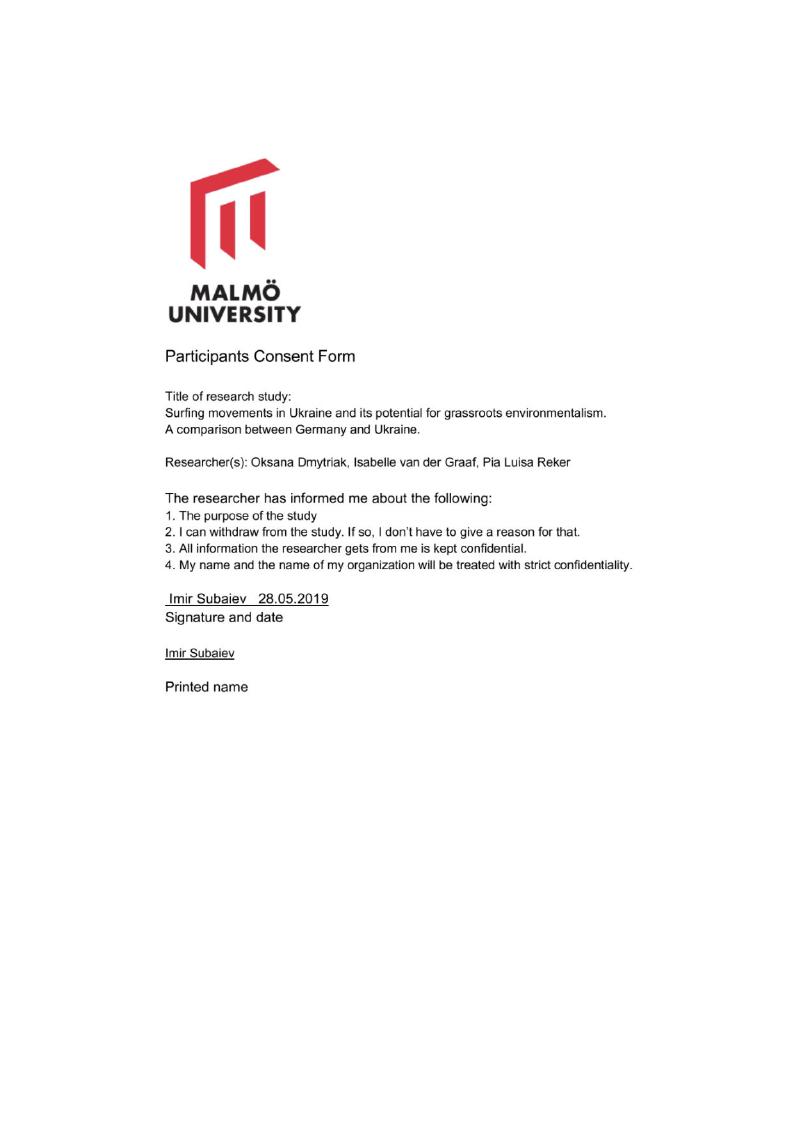
53
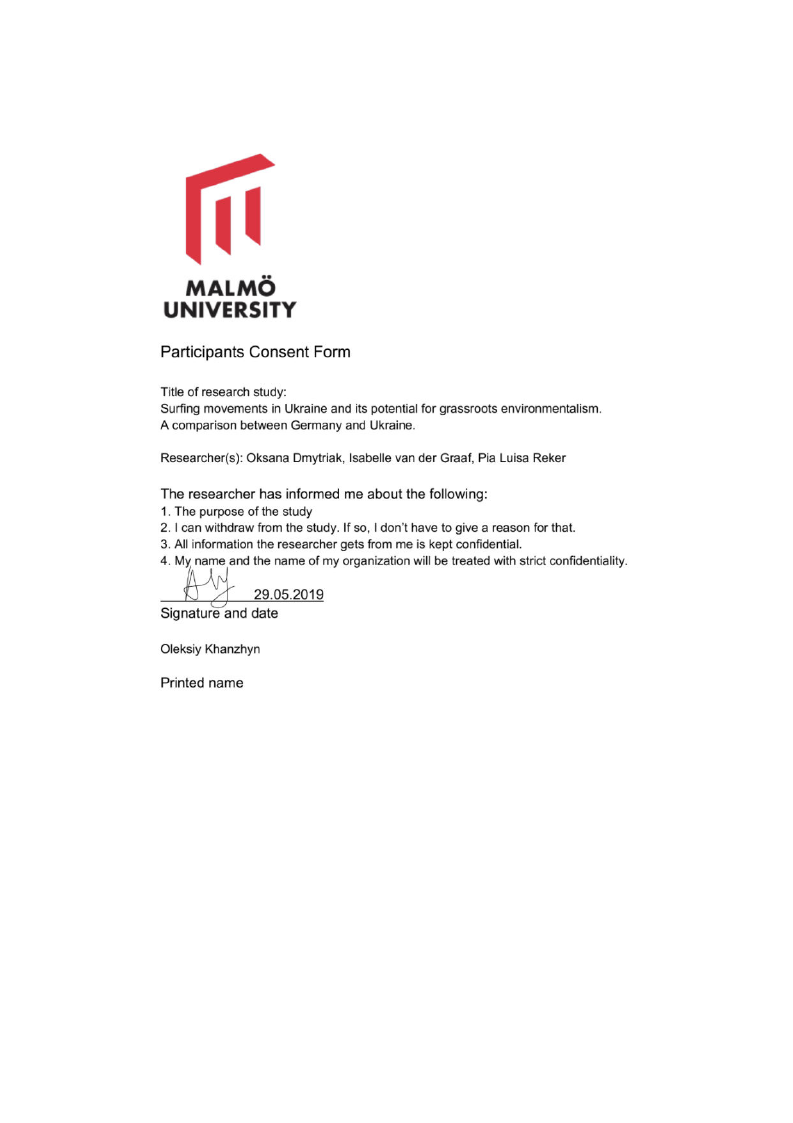
54
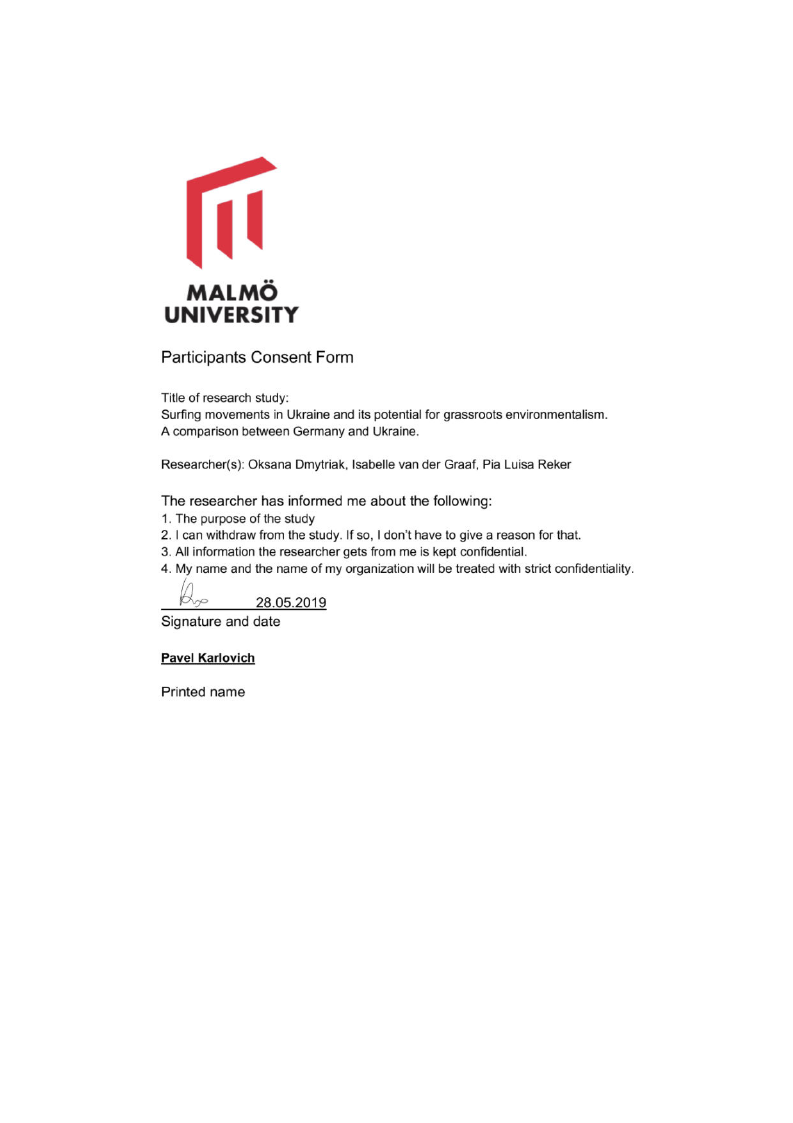
55
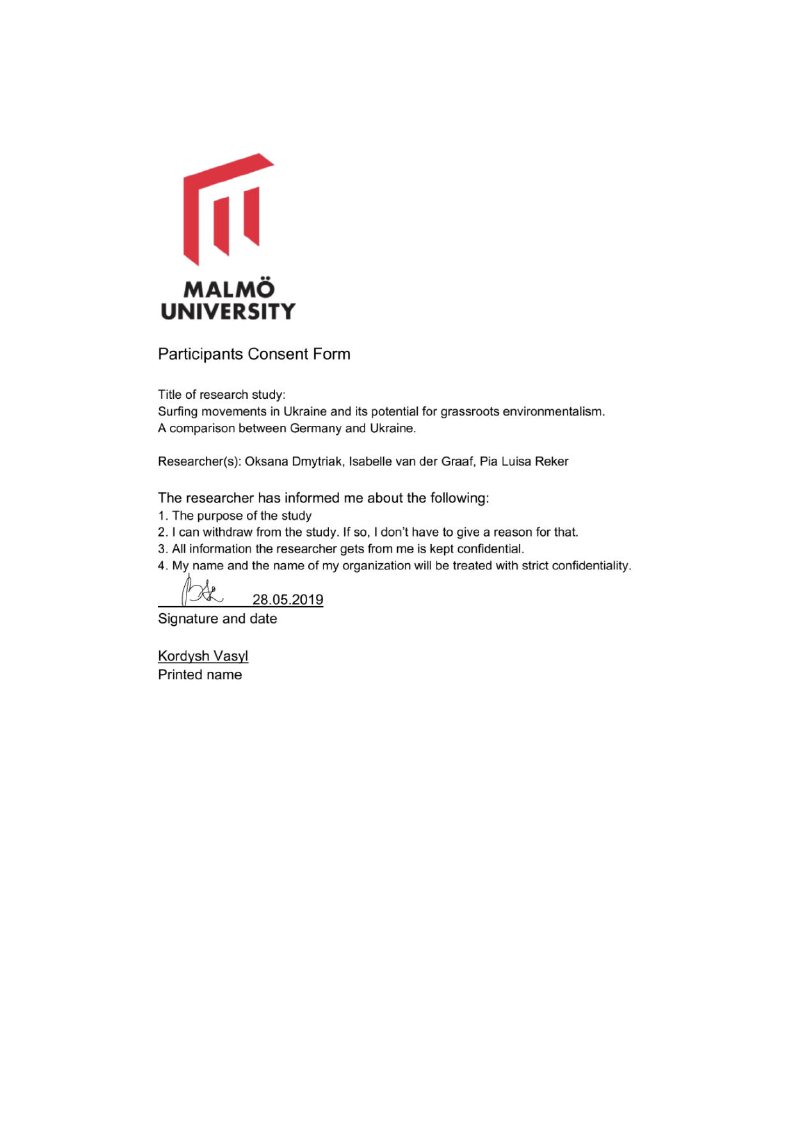
56
